Power 3.1
Support 2.8
Most blue decks can easily incorporate sufficient card quality and library manipulation to make the Temporal Mastery consistent. You have to phaff around a little more than you would with Time Walk and have far less control over when you can use it but it is actually the self exile which costs this card most of its rating compared to other Time Walks. It is subtle but stops you repeatedly abusing the Mastery which is where Time Walks really start to come into their own. With green recursion and blue reshuffle effects many decks elect to play both the 5 mana Time Warp style cards with the aim of casting them so many times the game is as good as over regardless of what else both players have been up to. The Mastery can be used once only per game and will offer a tempo boost anywhere from minor to game winning however as you have slightly less control over when you can use the card the tempo boost tends to be on the minor side and when you have upped your count of things like Brainstorm, Ponder, Divining Top and See Beyond to up the consistency of a card you fail to get as much value as you would like. As such very few decks build around the Mastery and instead just throw it in as filler when they already have enough supporting effects. Often this is with the other two good miracle cards, Terminus and Bonfire of the Damned, which are both better cards than Mastery when hard cast and also easier to reuse thus increasing the value of your support cards. Taking another turn is never bad for any deck, especially at the bargain price of two mana. The main difference between Mastery and actual Time Walk is that you don't draw a card with the former on the turn you play it as you have to rip it off the top and so you already need to have most of what you want to do with you next turn in hand. You can plan a lot better when you have the Time Walk in hand and will gain a lot more from casting it than you do most times with Mastery. A strong and powerful card for both tempo and control decks alike however not a card you specifically build a deck to house it in.
Stroke of Genius 1.4
Power 1.2
Support 1.7
Stroke is a more powerful card than the cheaper Brain Gyser. When this card starts to become playable a mana here or there makes little odds. Being instant however is of huge importance to the card. It makes it far stronger card draw in control decks and easier to cast with ramp decks and infinite mana combo decks through counter magic. Generally though this card is just too slow and useless to see much play in any deck that is not focused on generating massive amounts of mana. Control decks need to hit about seven mana before this is comparable to Fact or Fiction and so only play it when they are expecting to be ramping a reasonable amount. Stroke saw more play as a Wish target than it ever has as a main deck card and with the loss of Cunning Wish and Tolarian Academy it has seen even less play. Despite this the card offers versatility as both card advantage and a potential finisher in infinite mana combo decks. While rarely played in the more constructed formats where more efficient options are easy to come across Stroke is far more acceptable in the more limit formats which are slower and less consistent. Powerful card draw that is easily splashable and that scales well as the game goes on is perfect for the slower and less consistent formats. While Stroke has the potential to be highly powerful it almost never has the chance to realise that potential in my cube as it is too fast and consistent to allow decks to get a good Stroke off.
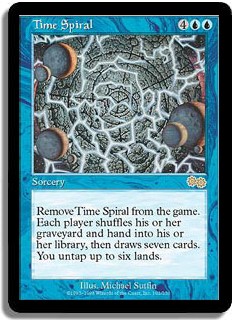
Time Spiral 4.5
Power 4.7
Support 4.4
Although not an auto include in any blue deck the Time Spiral is about as powerful as it comes. Originally I banned this card along with the other bannings but felt it was more reasonable without Academy, Time Walk, Lotus and so forth and brought it back in. Compared to Twister the only real disadvantage this card has is that it gets removed from game which rarely comes into play. It can be restrictive in some combo decks like storm as you know you only get one shot at going off with the Time Spiral however it is so stupidly powerful in those kinds of decks you are very likely to be going off any ways. Having to wait until six mana is not a great problem as you usually are casting it as one of the last spells you have. Having around three more mana available to use with your new cards is much more powerful than the ability to cast it sooner. Certainly it is worse to have this countered than a twister but given that you are casting a spell of this nature you are probably losing regardless of the extra mana you will have up after failing to resolve a twister instead of this. When used in combination with things like heartbeat of spring this card goes from slightly better than time twister to really quite unfair. One of the most powerful combo enablers printed and while not always played it is certainly always a worthy consideration for a deck with access to blue. For agro decks it is a way to refill the hand you have emptied faster than your opponent and continue to immediately apply pressure. For control decks it is a great way to get to reuse your precious specific removal cards and threats in the long games. It is preferred to Timetwister in this role as it gives you much more ability to cope with what your opponent does with their new hand due to the untapping of lands. It is however unplayable against certain matchups as they will always be able to take a greater advantage from the new hand such as red deck wins. Mana cost aside time Spiral offers one of the most powerful effects available in cube alongside Upheaval, Death Cloud, Balance, Vataclysm and the various destructive red spells like Wildfire and Jokulhaups. It is a cube mainstay and one of the very few cards worthy of consideration in the same league of stupidity as Ancestral Recall and pals.
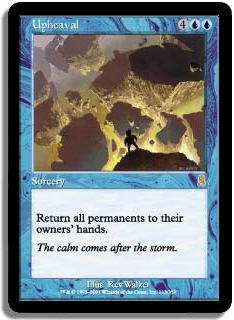
Upheaval 3.6
Power 4.2
Support 3.0
As just mentioned Upheaval is one of the most powerful effects in magic and in a colour generally lacking in this area. A deck needs to have certain aspects to it in order that upheaval be a consideration but when it becomes an option it is about as good as it gets. Either you cast this and win shortly after or it bails you out of an otherwise unwinnable situation. The best home for upheaval is in artifact mana decks using Mana Vaults and Grim Monoliths to generate mana both leading upto an Upheaval and as a result of casting it. The banning of Sol Ring, Tolarian Academy etc have reduced the play seen by Upheaval hence the rating variance. Trying to use this in control effectively is much harder too with a lack of Moxen making it to slow to be an appropriate win condition and ending up most frequently used as an out which resets the game slightly in your opponents favour. It is hard to get to the mana in control decks where you can pool enough to make a decent threat post Upheaval. A great and unique card that should be in all cubes that have fast mana. An answer to everything and a mass removal spell in blue that no decks are immune to the effects of. This is very much a card you build around and when you do it right it will win you an awful lot of games,
The S**t Walks 3.4
Power 3.3
Support 3.6
Power 3.3
Support 3.6
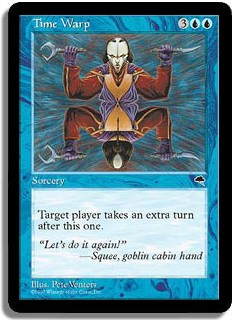
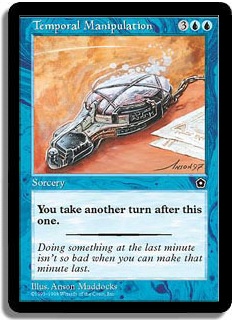 Technically the Temporal Manipulation is better as you cannot have it target you opponent via a misdirection or something. As I presently have no such effect in my cube, or any thing that gives a player shroud these are functionally identical. At two and a half times the cost of original time walk they start to feel roughly balanced. Quite a bad card in early draws and quite variable in power once five mana is reached. Utterly game breaking and unfair is what this card offers at best, and effectively a zero mana cycle at worst. This spell has been used to bore magic players heavily in cube for a long time frequently getting chain cast from bouncing Eternal Witness or Time Spiral effects. If your deck can deal with clunkier starting hands with Brainstorms and Force of Will then there is very little downside to the time walks effects assuming you plan to reach five mana in the course of the game. Even more powerful with planeswalkers and more recently the addition of Snapcaster Mage allowing for more blue mage tedium. While these fit in almost any deck using blue their unpredictable nature negates them being auto includes with players often opting for the more dependable spell. There are a few combos that make use of these effects such as Panoptic Mirror, the best of which by quite a long way is the blue green Heartbeat of Spring style combo deck which can win with storm or infinite mana or infinite turns. Combo engine decks are better to include in a cube than combos that depends on two or three specific cards. Although presently stripped to the bare bones, a few variations of heartbeat combo are all that presently remain of pure combo archetypes in my A cube. The decline of combo however has not really affected the frequency of these reasonably costed time walks seeing play. They are great in agro and tempo decks assuming you can stomach them in your opening hands as you will have a good board position for them to abuse. They are also great in control decks where they can really start to shift a game in your favour despite a reliance on small incremental gains for the most part, especially early. Just bridging the gap from four to six mana so as to cast that Merciless Eviction or Inferno Titan that saves you is frequently game winning.
Technically the Temporal Manipulation is better as you cannot have it target you opponent via a misdirection or something. As I presently have no such effect in my cube, or any thing that gives a player shroud these are functionally identical. At two and a half times the cost of original time walk they start to feel roughly balanced. Quite a bad card in early draws and quite variable in power once five mana is reached. Utterly game breaking and unfair is what this card offers at best, and effectively a zero mana cycle at worst. This spell has been used to bore magic players heavily in cube for a long time frequently getting chain cast from bouncing Eternal Witness or Time Spiral effects. If your deck can deal with clunkier starting hands with Brainstorms and Force of Will then there is very little downside to the time walks effects assuming you plan to reach five mana in the course of the game. Even more powerful with planeswalkers and more recently the addition of Snapcaster Mage allowing for more blue mage tedium. While these fit in almost any deck using blue their unpredictable nature negates them being auto includes with players often opting for the more dependable spell. There are a few combos that make use of these effects such as Panoptic Mirror, the best of which by quite a long way is the blue green Heartbeat of Spring style combo deck which can win with storm or infinite mana or infinite turns. Combo engine decks are better to include in a cube than combos that depends on two or three specific cards. Although presently stripped to the bare bones, a few variations of heartbeat combo are all that presently remain of pure combo archetypes in my A cube. The decline of combo however has not really affected the frequency of these reasonably costed time walks seeing play. They are great in agro and tempo decks assuming you can stomach them in your opening hands as you will have a good board position for them to abuse. They are also great in control decks where they can really start to shift a game in your favour despite a reliance on small incremental gains for the most part, especially early. Just bridging the gap from four to six mana so as to cast that Merciless Eviction or Inferno Titan that saves you is frequently game winning.
Tezzeret, the Seeker 3.5
Power 4.2
Support 2.9
I had this guy down as the best planeswalker in the cube for a long time. It is more the result of him only fitting in certain decks that tend to have a very high overall power level that Tez shines so much. Typically he gets cast on turn three, untaps some artifact mana and casts a time walk immediately which is then followed by using his ultimate for the win. His ultimate is the most used of any planeswalker in the cube. In many ways he does what Garruk Wildspeaker does yet while costing more mana he still tends to be quicker than Garruk, if not as useful in any old archetype. Typically untapping two artifacts will net you a lot more mana than two lands and you can get more artifacts into play quicker than you can dorks as well as them being more likely to all still bei n play in time for your ultimate. Tezzeret works well in big artifact mana decks, an alternate win mechanism in affinity or a tutor effect for combo decks using artifacts such as Sword of the Meek + Thopter Foundry or Painters Servant + Whetstone. While being the most restricted walker Tez still shapes up very well for his overall power and synergy. As soon as you have a critical mass of artifact mana sources and cheap aftifacts Tezz quickly becomes the most powerful planeswalker. He has much more immediate impact than any other walker and is able to use his ultimate to lethal effect more quickly and reliably than all the others. Obviously like Upheaval and some other cards he is of much higher power in cubes with Sol Ring and the other artifact power cards yet he is still abusive in the right deck, jsut the cards for those decks are not as abundant or as overly powered.
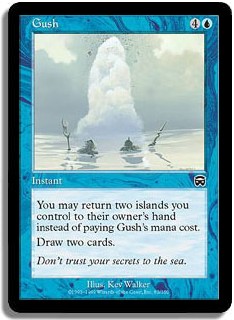
Gush 2.4
Whenever a spell can be cast without mana it warrants much looking at. The alternate cost on Gush is savage in some decks or in some situations while beneficial or at least harmless in others. This is made up for to some extent by a fairly reasonable standard cost and by being instant. With Library of Alexandria Gush was especially useful in refilling your hand very effectively while not giving your opponent a new grasp of seven as well. Now its best use is for powering up Foil. While its best use may be minor it is a versatile card that offers lots of trickery to its wielder and can see play in all kinds of decks. Most commonly these are aggressive decks using evasion monsters to curve out and full of free disruption to back them up. Gush helps power out these threats and disruption, the latter of which often cost card advantage to use. Numerous combo decks have put Gush to use, some actually able to generate mana with it in Fastbond style decks of old. Control is the least common place to find a gush as they rarely want to lower their land count but it does provide unique options for them and is fine as a card to pitch to Force of Will etc or just hard-cast late game at the end of one of their turns in which you didn't need to counter something. Gush is a very neat little card with some great applications and synergies. It does not have the most raw power but ticks all the right boxes while being unique in design as well meaning no real alternatives ensuring it a cube spot for the foreseeable future. Gush is one of those few cards that is able to find a home in agro, control and combo when it works with what they will be doing.
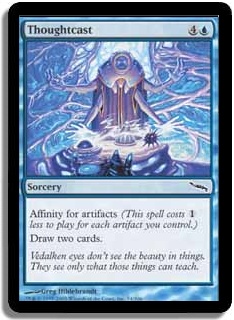
Thoughtcast 1.9
Power 2.3
Support 1.6
Less narrow that many of the affinity mainstays this card is still only playable with a high artifact count. At three or more mana to play you are falling way short of the power level required of cube. The sorcery aspect of this card is not too significant as you are aiming to cast it for one which is so little you would rather have the extra options from drawing in your turn than leaving mana open most of the time. Pure draw cards don't often find their way into beatdown decks as they are not an investment that provides tempo. The main exceptions to this are Thoughtcast, Gush and Ancestral Visions/Recall simply because the cost is small enough to play them that tempo loss is not much of an issue. The worst part of this card is the fact that is always needs a blue mana and would likely be much more exciting as a 6 or 7 mana colourless spell. Often this card causes damage to your tempo as you don't have access to blue. It requires careful mana base consideration as well as artifact count and costs for Thoughtcast to be an option however when it is it becomes and auto-include whatever your deck is.
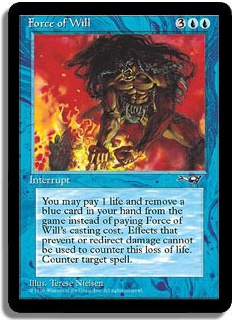
Force of Will 4.6
Power 4.6
Support 4.6
More than any other question most games in the cube end with; Force of Will? Free counterspells are great offering tempo gain and the opportunity to be more proactive and Force of Will is leagues ahead of the others. Being a hard counter that only costs you one card to pitch cast with a playable standard mana cost makes this an auto include in almost any deck with enough blue cards to pitch. You don't even need to be running lots of card advantage to make back the cost of this spell as it is just so reasonable. Exiling a card rather than discard can be annoying in singleton formats for combo and control decks as the cards they often most want to pitch early are the most important cards in their decks for winning. Nothing makes you feel safer in magic than sitting on a Force of Will and some situational cheap spell to pitch like a force spike. The bannings have made the best cards in the cube much closer in power level and this is one of the strong contenders.
 Tamiyo, the Moon Sage 3.2
Tamiyo, the Moon Sage 3.2
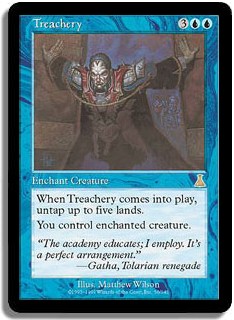
Treachery 4.0
Power 4.1
Support 4.0
If they have no sacrifice mechanism or no counterspell then Treachery is a total wreaking. Getting to remove their best guy and get it for yourself at no mana cost is about a big a swing in Magic as you can hope for. Treachery, when working as intented is card advantage, tempo advantage, removal, and a threat. If they do have a way to fizzle the spell and thus negating the land untap paying five to bait a counterspell or kill a guy, even in blue, is far from a bargain and the loss of tempo from which can be fatal. This is the infrequent worst case scenario which is easy to play around. Best cast scenario, which is most of the time you hit five mana and expend one card and an average of one mana to kill their best guy while getting one for yourself. Even if they untap and immediately kill the Treachery you have gone one for one on cards, gained mana advantage and caused them to lose attacks. Treachery is hard to deal with as it is an enchantment and often requires them to kill their own guy giving you that great two for one feeling. The mild downside of this card clogging up your hand until you hit five mana is least problematic in blue with much filtering, pitching and reshuffling effects to smooth things out. A strong contender for any heavy blue deck, control or agro. It is weakest against goblins and affinity which have primarily small creatures you are not too exited to steal, as well as both decks having a great number of ways to instantly sacrifice dorks and fizzle your untapping of lands.
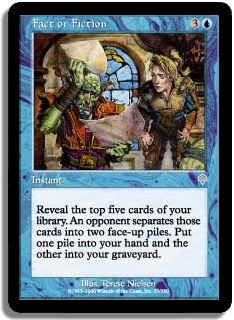
Fact or Fiction 3.4
Power 3.6
Support 3.3
An outstanding card from many perspectives. It gives your opponent the chance to make mistakes, offers interesting choices to the caster, digs deep into the library for when you need a specific spell, costs only one blue mana to cast, is instant speed, guarantees three for one card advantage at worst, fills up the graveyard and just so often causes someone to scoop in favour of dividing up three or more things that beat them. The instant is the key aspect of the spell making it playable in control with four mana being a risky investment to make in a main phase. Its cost makes it compete with other very appealing spells and rules it out as an option for some combo decks and high agro low mana curve decks. Still, this is about the most all round card draw spell in the game after Ancestral Recall offering a good quantity of cards for a reasonable cost with no stipulations or real drawbacks all rounded off with the essential instant speed to offer the complete package. The few slight drawbacks you could accuse this card of are danger of losing vital combo pieces in singleton format and the information it gives your opponent on your hand. Neither of these are enough to even affect the cards rating however. Most newer card advantage spells are permanents such as planeswalkers and creatures which can be harder to support and protect in certain decks. You can easily get more card advantage out of a Jace than you can from a Fact or Fiction however the latter is far more likely to net you more cards on average for not being so situation dependant. A final point about Fact or Fiction, in a 40 card deck it immediately mills about a 6th of your remaining library, often more, which for the more control decks does mean you need to be able to win in reasonable time or at the very least use a reshuffle effect. Despite its vast power and effectiveness compared to most other pure draw spells it is a card that costs 4 mana and does nothing to the board or your opponent which makes it harder to play in decks and harder to cast than it is in slower, less powerful formats.
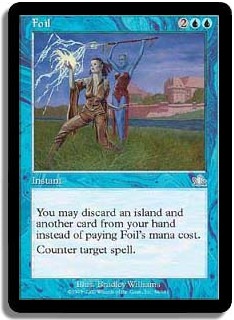
Foil 2.0
Power 2.6
Support 1.5
As free hard counters go this is a long way off a Force of Will. Twice the card requirements to cast for free and usually harder to fulfil the pitch cost does not makes up for the one less mana it is to hard cast than Force. The card disadvantage is too much for most control decks to stomach, particularly as one is a land which often leads to situations where you think you will lose if you don't counter the spell but missing your next land drop will also likely cost you the game. Foil works wonderfully with Gush and most frequently finds a home in aggressive fish and skies style decks that lay down cheap evasive or disruptive creatures and support them with cheap and free counter magic. For free hard counters after Force of Will there is little to chose from and Foil is pretty clearly the second best with all round consistency and application. Less so with the Island but the discard can be utilized to the casters advantage with various graveyard focused decks which is one utility Force of Will cannot offer due to exiling the pitch card. Foil, like Force of Will becomes harder to play the less blue your deck becomes but with Foil starting out more demanding in its alternate cost it only gets harder relative to Force as you entertain more colours. A slightly easier normal cost means you are pretty happy to hold this as emergency backup and never actually pitch cast it.
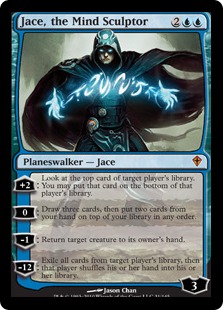 Jace, the Mind Sculptor 4.4
Jace, the Mind Sculptor 4.4
Power 4.4
Support 4.5
The middle Jace is the second best all round planeswalker in the cube after Elspeth. I am sure many people will argue with me and say that Jace is the better of the two, and it is fair to say it is very very close between these two and then quite a jump down to the next walkers in power level. Both cost 4 mana and can go directly to 5 loyalty if required. Elspeth can protect herself from a +1 effect while Jace can only bounce dorks for -1 should he need to protect himself. This downside is somewhat offset by Jace having a +2 effect to recharge the lost loyalty faster. Both of these walkers are unique in that Elspeth has two plus loyalty effects and Jace has four not three abilities. These obviously help their overall power and allow them to perform a useful role in most white or blue decks accordingly. My preference for Elspeth over Jace is down to fact that Elspeth will win games all on her own, Jace on the other hand just helps your deck to win more easily. If your deck is a poor match-up or just a bad deck the Jace will not be so helpful. The other main reason for a preference for Elspeth is that she will continue to grow in power while being useful in a board position full of dorks. Jace can only really allow you to pull away from your opponent if the board is empty or static. I have spend a long time detailing why Elspeth is marginally better but the difference is pretty minor, both are extremely powerful and outstanding first picks. They both really set the bar for other 4 drops in those colours, particularly non-instants, and prohibit any play from loads of other 4 mana cards that really don't compare well to them. If you drop a Jace onto an empty or static board with counter backup you should win almost every time. Brainstorm is a highly synergic and abusable effect that is weak in no decks at all. Unsummon is a strong and versatile self protection ability that works well in and against most decks. It is far better against midrange and control threats than it is against weenie agro decks however the ability to +2 Jace offsets this rather as they are still mostly forced into trying to kill off Jace meaning you can take huge amounts of pressure away form your face. The ultimate is very rare to use but is a fairly reliable win mechanism if you need it to be and if far more useful than (4 mana) Elspeth's ultimate.
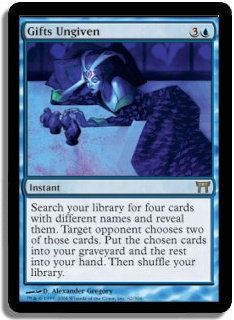
Gifts Ungiven 3.2
I tend to find that most blue based control decks will play either a Gifts Ungiven or a Fact or Fiction. When you just want to draw cards the Fact or Fiction is the superior choice however if you have any synergy the Gifts becomes exceptionally powerful. It can completely set up your engines or find all the things you need to gain control and win from the situation. Rather like a Jace but requiring a tailored deck, if you can resolve a gifts at a stage in the game where the board position is empty or static you should invariably go on to win. In a singleton format the Gifts acts like a super juicy Intuition and with appropriate graveyard recursion works like a double tutor spell. Snapcaster Mage has added to the toll of cards that work particularly well with Gifts which previously included Eternal Witness, Life from the Loam, Chandra's Phoenix, Genesis, Cabal Therapy and basically anything else that has some effect involving graveyards. The great thing about Snapcaster is that it is also blue which the other support cards are not. I can imagine post Dark Ascension that a particularly strong set of cards to get would be Faithless Looting, Geistflame, Chandra's Phoenix and a Mystic Revival. Gifts can be used in reanimator decks however at 4 mana it is not a fast way to get things in the bin. Most commonly found in UG based control decks of three or more colours so as to most abuse the graveyard based aspects. Gifts is another fantastic card that really allows people to play Magic, offering loads of options and difficult decisions for you and your opponent.
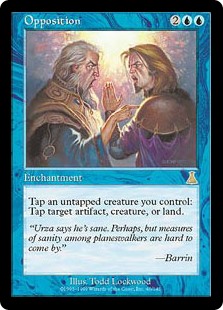 Opposition 4.1
Opposition 4.1
Power 4.3
Support 3.9
This card has got better and better as blue has gained more and more high quality low cost monsters. It was a fantastic spell when first printed any way. Back then creature decks would splash blue for Opposition and perhaps the odd other sub-par card, now blue can be the base or only colour in an Opposition deck. If you can get far enough ahead on the board an Opposition is game over, being able to shut down all mana sources or all creatures or bits of both as required. Opposition is a card that loves to be placed with tempo creatures like Aether Adept and Lotus Cobra. Opposition starts to be good in any deck with 10 or so dorks (in 40 cards), as you increase the synergy of your dorks and other cards for Opposition it goes from being a solid card to being the best card in the deck. I can't remember a straight UR Opposition deck having been done (might have to try one now) but every other colour combination, including 3 colours, has seen it used. The most typical version is UG although mono blue versions have been increasing wildly in popularity over the last few years. Opposition utterly dominates a game giving great control and a wide array of options to its controller. You can entirely base a deck around it or just throw it into a deck with sufficient creatures and it will perform very well.
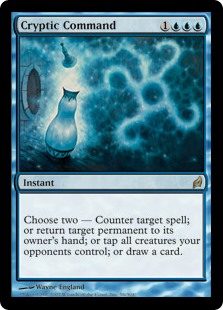 Cryptic Command 4.2
Cryptic Command 4.2
Power 4.4
Support 4.0
This is the card I was most wrong about with my initial assessment. I was not at all impressed with what I essentially saw as a four mana counterspell. I was finally pressured into adding one to the cube and was simply blown away by how off the mark I was. I now consider this to be the 3rd or 4th best counterspell of all time. It is far more like a Time Walk than it is a Dismiss, the counter aspect is used most frequently when it is a big spell that required the caster to tap out. When facing weenie decks it is much less often used to counter things instead focusing on tapping down dorks. In both situations when combined with the card draw ability it looks and feels like you are negating their turn without cost to yourself. Triple blue was a huge turn off for me too but my attitude has changed rather more to throwing in an extra blue filter land to my deck to make casting it easier. The strength of the card is in its vast applications. Each of the abilities is situationally useful with the draw always being consistently fine when you only require one of the others. The card makes you feel safer than your average counterspell as it can be effective once a card has resolved. Cryptic just offers everything, card advantage, tempo, flexibility and an out in so many circumstances. If my deck can just about support the mana requirements I will be happy to play this card, pretty much regardless of what else the deck is doing. While best in control decks it is still very powerful in more aggressive strategies. It is quite hard not broadcasting when you have Cryptic in your hand but then it is also quite hard to play around it effectively even with that knowledge. The clear best of the Command cycle which is in itself impressive with both green and white commands getting lots of play and high ratings of their own. There are not many spells in Magic that offer a powerful and competitively cost effect that is so widely useful and that can get both tempo and card advantage through casting. Fire / Ice is the other card in this category that springs to mind and both are as good as auto includes for any deck able to cast them such is their strength.
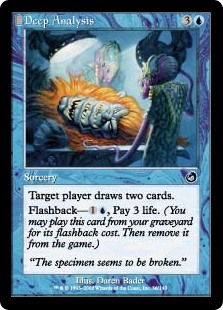
Deep Analysis 1.3 (B Cube)
Every one loves Deep Anal - nostalgia, card draw, innuendo, the card has it all! With the arrival of planeswalkers a four mana sorcery that has no effect on the board is really weak. Unless your deck has access to lots of mana or lots of discard this card in unplayable. Those with the mana tend to prefer more powerful spells and those with suitable discard outlets are few in number and usually not blue. When it can find a home Deep Anal is versatile and powerful enough but not wildly exciting. Life costs are very match up dependant being unusable versus red burn and irrelevant against most control. Generally not knowing how useful a card will be in your deck is pretty annoying too and reduces the play this card sees further. Madness is the best home for this card but the deck is tier two at best in the cube and blue has very little to offer the deck and will be a splash at best usually. Intuition and Gifts Ungiven are the cards that keep this viable for the cube and are effects that got more powerful with Dark Ascension but are still very slow. The slower control decks simply cannot afford to risk having a do nothing 4 mana sorcery in their hand and must have incredibly consistent discard. Reanimator decks which have the discard shy away a little from the life cost as it makes playing Reanimate either impossible or too risky. The more graveyard focused control decks such as Life from the Loam decks are too tight on space for synergic filler and obtain their card advantage through engines rather than single spells. The best home left for Deep Anal is storm combo decks which often have effects like Helm of Awakening or Sunscape Familiar which work doubly well on flashback spells as well as the ability to power up your storm count easily. While a very elegant card it is too narrow and too low powered to be a cube mainstay.
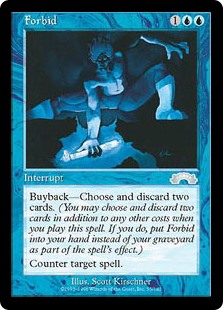 Forbid 2.0
Forbid 2.0
Power 2.2
Support 1.8
A hard counter for three mana, two of which blue is below the power level of cube. The buyback is expensive, can be risky and requires an engine to be of use more than once. That said, there are no other counterspells in the cube at three mana and few hard counters, particularly at low mana costs. I think forbid is one of only three hard counters that reside below four mana. The buyback may also be turned into an advantage should your deck have a requirement for discarding although this is a less common use than combining Forbid with an engine to soft lock your opponent out of the game. Typical engines include the classic Squee combo, now with added Phoenix, but Life from the Loam and even Land Tax can work just as well. Forbid is often thrown into heavy counter decks with minimal synergy as it slots into the curve neatly meaning the extra mana cost over many counterspells is not often too problematic. It then gives you the option of having more counterspells when the game calls for it, even at the cost of other cards this can be very handy. Cards that give you options are good, particularly when at least one of those options is a perfectly playable card on its own. Forbid is acceptable against agro decks, amazing against combo and non-blue control and one of the weakest counterspells against blue based control decks. It is one of many cards in the cube that allows you to soft lock an opponent out of the game while having the powerful upside of being perfectly playable without any shinanigans. Forbid tends to only find homes in heavy control decks as they can more easily support the buyback costs and are less put off by its three mana cost.
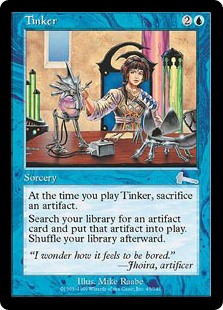 Tinker 4.1
Tinker 4.1
Power 4.3
Support 3.9
Tinker is one of those unreasonably undercosted and easily abusable cards. It combines the ability to vastly under pay for something very powerful as well as the ability to tutor for what you most need at the time. It does require support cards to the point of having to heavily build your deck around the card in order to make it playable but it pays huge dividends when you pull it off. In order to properly make use of Tinker you need several worthwhile things to get which typically start at 5 mana and go all the way upto 12. Usually these are threats like Myr Battlesphere, Blightsteel Colossus, Inkwell Leviathan, Sphinx of the Steel Wind and Wurmcoil Engine however Memory Jar, Gilded Lotus, Mishra's Helix and Mind Slaver are all reasonable targets offering different things. Some combo decks even run Tinker to find bits of the combo when the cards cost less than Tinker itself such as Thopter Foundry. More important than having sufficient worthy targets to get you also need an abundance of cheap artifacts in order to always have something to sacrifice. Ideally you would have no less than 10 useful artifacts that cost 2 or less mana. Usually these are mana generators such as artifact lands, talismans, Mana Vault and Crypt etc. I personally like to include as many Chromatic Star sytle effects as I can grab to help out with making Tinker castable as soon as. Fortunately lots of cheap artifact mana cards and some powerful top end threats basically make for a pretty powerful deck without Tinker and so the card slots right in without being a must draw to stand any chance of winning. Tinker costs you card advantage and is one of those high risk spells to run into counter magic or even just effective removal but the sheer power of the card makes this risk more than worth while.
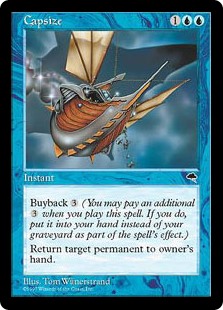
Capsize 1.9
Power 1.9
Support 2.0
This card is very like Forbid in lots of ways. A slightly over costed standard blue effect with an option to gain repeat uses. Also when set up appropriately, ie a huge mana advantage, Capsize can lock a player out of the game as Forbid can when you have huge card advantage although both require a fairly static board position to begin with as well as a substantial and ongoing drain on your resourecs. Bounce is surprisingly good in the cube as the loss of card advantage is rarely an issue with it being a very fast format and card advantage being relatively easy to regain in the right deck. Being able to have any permanent not in play at your will is useful against any deck but generally the cheaper bounce cards are better. The potency in spot removal lies in the mana difference between what you remove and what you used to do that with. Capsize as standard bounce offers far less tempo than most other bounce and makes it very much a last resort card when cast for three. As such the only homes for Capsize are ones that need at least 6 mana to do whatever else they plan to do so that they should get the chance to abuse .These decks include draw go control decks, blue green ramp combo decks and blue based artifact mana ramp decks. The decks in which Capsize is best are those which can get to a large mana advantage over its opponent very quickly such as turbo land, in a draw go control deck Capsize is just an underpowered spell until about turn nine making it a very unlikely inclusion over something like a Frost Titan. Wipe Away has replaced Capsize in the past but a three mana bounce spell with no late game perks is just too much mana to be consistently useful. the strength of Capsize also depends on your deck and cards while that of Wipe Away depends on what your opponent is doing and is much harder therefore to engineer it to be at its most powerful. It is a useful out card that doubles up as a sort of win condition in the very very late game that makes up for its low power over much of the game with its high flexibility. It only sees play when it is covering a few holes in a deck list simultaneously these days due to strong competition. A final plus for Capsize over much of the other good bounce is that it can hit lands which is very potent against the bounce land cycle.
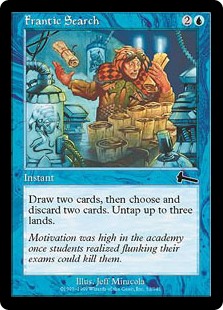 Frantic Search 3.3
Frantic Search 3.3
Power 3.2
Support 3.5
Card disadvantage at its best! This little gem seems to find its way into every single combo deck. The untapping land effect cards are all of huge power and this is one of the most generic as it costs little and just draws cards. The applications for Frantic Search feel endless and it winds up in decks other than combo ones. There are many strong reasons to include Frantic Search as part of an engine or for its synergy. It can generate mana with a wide array of cards that result in lands that tap for more than one. It also frequently fixes colour which may seem subtle but is of huge importance. It is a way to put cards in the graveyard should you have anything to put there, commonly for Goblin Welder or Reanimate. It is a free spell for ramping storm as well as a way to dig deeper into your library to find what you need, something any deck can get behind. Really the only single drawback this card has is that, like Careful Study, it is card disadvantage. For a way to do any of the above things without even the slightest tempo loss and often the chance of tempo gain you are generally more than happy to take the loss of the card on the chin. Frantic Search was often played regardless of your deck if you had a Tolarian Academy just for the tempo boost of a single uptap on it. My personal favourite home is the Heartbeat of Spring storm combo deck where you have little use of the discard but often get to generate four mana by casting it. Less common to find in agro decks as they generally have less urgent graveyard synergy and are less able to front the card disadvantage. Several years ago this would have had substantially higher all round ratings with my cube still being powered at the the time and combo decks still being one of the best archetypes.
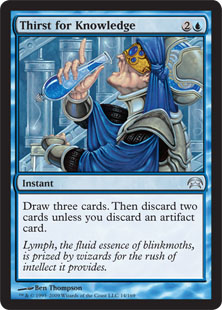 Thirst for Knowledge 2.4
Thirst for Knowledge 2.4
Power 2.7
Support 2.0
This has all the required aspects of a draw spell and a few more bonuses to boot. Instant speed and reasonable cost to cards drawn ratio being the main things the card has in its favour. When you are consistently discarding just one card Thirst is one of the best pure draw spells in the cube. Fact or Fiction is much more powerful however it is on a more awkward point on the curve leaving Thirst often the more convenient option. The discard can even be a bonus in some decks and offers some additional synergy for things like a Goblin Welder. The problem with Thirst is that it is very restrictive, when you are discarding two cards to it you just have a very expensive card quality spell that looks really bad compared to the alternatives. As such you have to have a high artifact count including cards you are likely to be happy to discard at various points in the game to make Thirst any good. Even with artifact lands and Moxen it is tough for control decks to reach the required artifact count and so Thirst sees less play than most of the other decent card draw spells in the cube.
 Jace Beleren 3.0
Jace Beleren 3.0
Power 3.0
Support 3.0
Three mana planeswalkers are very powerful as they enter less scary looking boards and have more chance to power up. While Jace cannot protect himself he can go directly to 5 loyalty which is hard to kill, and if they do manage to kill him the tempo loss that early is usually worth the costs. Versatility is the one of the strengths of walkers for which mini Jace is no exception. On a stable board you can either ramp and use as a win condition or run down for a somewhat slow Ancestral Recall. As you have the control of when you draw and when you both draw combined with the fact you have a steady stream of cards coming your way it is pretty easy to take control of a game with an early Jace rather like a Phyrexian Arena or a late to the party Library of Alexandria. In 40 cards decks the ultimate is pretty deadly and also fairly easy to get too. Certain walkers are a bit of a bum as you cant have multiples in play, Jace being able to usefully run himself into the ground to make way for his middle brother makes it much more comfortable playing both copies in a deck. High quality cheap card draw is hard to come by and Jace is not the best in that role for being slow and sorcery speed. He is however a great supplement to a deck slightly lacking in that area as he offers so much more than just draw, being both a tempo changer and a potential threat.
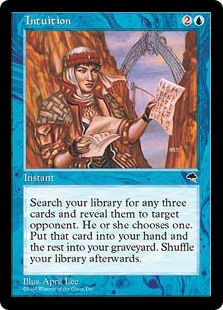 Intuition 1.7 (B cube)
Intuition 1.7 (B cube)
In the singleton format Intuition is just a bad Gifts Ungiven as it cannot get three copies of the same spell and act as a tutor. Offering no card advantage and requiring (ie being able to find three spells that will do the same thing) the exact same redundancy as Gifts makes it far less playable in control. If only you could still get three copies of Accumulated Knowledge with it... The classic get a pile of lands play is a fine alternate use for the card but no reason to be playing it alone. As such Intuition see play in very specific circumstances which are all to get cards you want to have in the graveyard. Sometimes used instead or as well as of Buried Alive in reanimator deck and sometimes used to find a whole bunch of cards you want in the yard thus being able to offer effective card advantage. While cute, these strategies tend to be a little slow compared to just playing better card draw and better cards. I do love to get a Giestflame, a Faithless Looting and a Chandra's Phoenix but I refer you to my previous point. The best home for Intuition in the cube is with Life from the Loam as the extra turn you get to start Loaming vastly outweighs the extra card you would get from using a Gifts Ungiven to set yourself up in the same way.
 Timetwister 4.0
Timetwister 4.0
Power 4.3
Support 3.8
Seven cards for three mana is lots of cards for not much mana. While the effect is symmetrical you get first usage on the new cards, even if you are three mana down. The fact that it kills all players current hands means that you can gain huge card advantage from it when they still have a full grip and you are nearly out of gas. There are two kinds of deck that will play Timetwister over Time Spiral. Those decks that never intend on reaching 6 mana and dump their hands very quickly such as an affinity deck and an array of UG(x) decks that want the ability to recur Twister from the graveyard to cast numerous times. In most control decks I feel vulnerable without access to one of the various graveyard reshuffle effects (this includes Primal Command despite the lack of drawing seven cards on the card). Control decks have few threats and in a singleton 40 card formats you can easily deck yourself in longs games and need to use certain cards multiple times. Timetwister solves these problems and offers the chance to get huge card advantage at the same time. While both useful, powerful and abusable the symmetric nature of the card does mean that casting it is usually of great benefit to your opponent and becomes dangerous or unplayable in many games and match ups. Often the bane of black control decks who cannot much affect the tops of libraries and will lose to you top decking this even after destroying your whole hand. Timetwister is the only member of the power nine which is not plain unreasonable and is even harder to abuse without the rest of the power cards to charge it up.
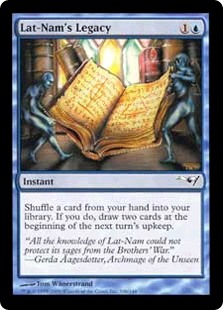
Lat-Nam's Legacy 3.2
Power 2.8
Support 3.7
This is probably my favourite of the cheap card advantage / card quality spells. It is the next best thing to a Brainstorm and better in many situations. A 2 mana instant that can draw you two new cards is the perfect thing to cast at the end of your opponents turn in which you did not need to counterspell anything. As with so many things it is the instant speed of this card that makes it so much better than See Beyond in control decks. I have the original Alliances version in my cube which mentions none of this nonsense about only drawing cards if you reshuffle one. As such in my cube we play this as allowing you to cast it without anything to discard and have it still draw you two allowing it to function as card advantage too. This rarely comes up but is a cute little buff to the card. It is also the next upkeep you get to draw, not just your upkeep so if you main phase play it you will have any counterspells in time for their main phase. This can however be an irritation if you need to dig for lands as you want the cards right then. It has its own shuffle mechanism and so does not require other cards like sac lands to get rid of chaff spells like Brainstorm does. A delayed draw is really handy to combo with cards like Balance or to evade cards like Mind Twist which in my book makes up for being worse at getting lands than other draw spells. There are also precious few ways to get cards from your hand into your library which is very important for a variety of combo decks in the singleton format of cube. A highly versatile and tricksy card that makes for better and more interesting games and a card every cube should have a copy of. It is just one of those innocuous cards that you can play well with and get huge mileage out of.

See Beyond 1.6
Power 1.5
Support 1.7
This is a handy card but lacks the utility of Lat-Nam's Legacy. It can never net you cards, nor protect your hand or complement counter magic well. As a card quality spell the various one mana Ponder and Preordain cards are much better unless you specifically need to be putting cards from your hand back in your deck. The one advantage it has over Lat-Nam's is its speed, not as in sorcery as clearly the card is worse there, but in terms of getting immediate effect and as such the See Beyond can be the more popular choice for combo decks. See Beyond is more consistent than Lat-Nam's but is never interesting, its not even a very useful shuffle effect... It is in the cube for the rarity of effects that return cards from your hand into yourlibrary. It can be just what a deck wants and is perfectly OK in most blue decks but otherwise is a very low power card that tenuously remains in the A cube. It digs less far and costs twice as much than the good one mana card quality spells and is a card I would love to replace. It just gets far too much play for this to happen yet. Even when you have no specific need to return certain cards to your deck such as for Oath of Druids or Tinker it is still often vastly preferable to discarding the card in question. In control decks especially you play your top end for a reason, you need the various things your top end offer to win games but they are still duds for the first part of the game. Being able to put them back in the deck to draw at a later more convenient date is far better than putting them well out of reach in your graveyard and denying yourself certain key options for your deck. A great example of this is Austere Command against affinity which if resolved will almost certainly be game over but will just clog up your hand for the first four or five turns, perhaps more if you are not finding lands. It is for this sort of subtle reason See Beyond is a valuable card quality and filter mechanism in a singleton format with 40 card decks.
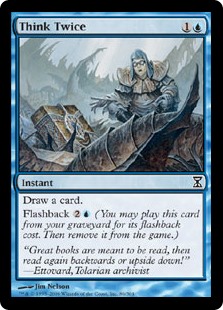 Think Twice 2.0
Think Twice 2.0
Power 1.5
Support 2.7
This is not a cheap spell but it offers a lot of what you want from the kinds of cards that are used to smooth out draws. It is instant and so like Lat-Nam's Legacy may be used with instant disruption to maximise your mana efficiency. It is also quite like two distinct spells, the first half is just a cycle when you are light on lands or have spare mana, the second half is a bit more of a mana investment but turns it into card advantage. Essentially it is like having both a 2 mana cycling card which then morphs into an instant speed Council of the Soratami. Although you don't get two cards when you flash it back you have gained card advantage overall. Paying the extra two mana much earlier in the game is great to get the first card early and still completely fine if you never get round to flashing it back, chances are if you had played a three mana draw spell instead you would have got not value from it at all due to having no chance to cast it. Cards like this are really good for fine tuning your mana to spell ratios in decks, typically for control, hitting all the way to your 4th land drop is hugely important. This helps with both the third and fourth depending on how desperate you are. I would rarely take a two land hand with a control deck but a Think Twice would be one of the more likely cards to convince me if I had it. While it is very uninteresting when you only flash it back it is still a much better card to be putting in the graveyard than most. Any synergy with Gifts Ungiven or discard effects do increase the value of Think Twice if only by a little. It has some additional merit in storm decks where it is able to generate lots of storm by itself and doubly benefits from mana reduction effects like Helm of Awakening. A low power card that is outstanding filler and smoothing for control decks and a few combo decks.
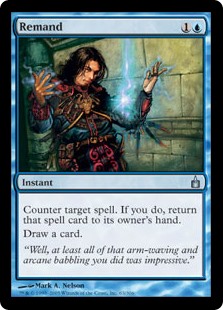 Remand 3.6
Remand 3.6
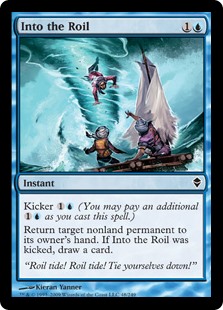 Into the Roil 1.9 (B cube)
Into the Roil 1.9 (B cube)
Bounce is really quite useful in the cube, it is cheap, usually instant and hits a wide array of targets. Bounce offers you tempo in exchange for card advantage which is perfect for blue which is easily able to draw card but struggles to get a good board position. The thing with bounce spells is that there is a vast choice of which many are comparable. Into the Roil, Boomerang and now Cyclonic Rift all compete with each other for cube slots and all offer their unique upsides. On top of these three there are many many more bounce effects bolted on to dorks and spells that have their own additional applications. I am surprised by how much bounce the cube supports and have continued to add in bounce but still don't feel there is room for all three of this, Boomerang and Rift. The reason that Into the Roil has taken the bench for the time being is that it is the most middle ground of the options. When you play a card like this you are either very low on out cards and need a catch all such as in a combo deck or you are concerned about tempo and want some all round cheap disruption. In both these situations you don't really care about the kicker option, it is nice and it may come up if the game goes unexpectedly long but shouldn't come up when you are using the card in its intended role. If you want cards that bounce and don't cost you card advantage you have far better options in Cryptic Command, Venser etc. The 1U cost is more convenient than the UU for Boomerang but it tends to be heavy blue decks packing bounce any way and so Boomerang's ability to hit lands easily trumps the cost difference. Into the Roil can target your own things, which is relevant, and Rift cannot. Again however, it is not the main function of this kind of card, the sheer power of the overload is far more exiting than the ability to just draw a card and gives a whole extra avenue to your deck list. So Boomerang and Rift make for a good blend of fairly polar options with convenience of use or convenience of casting and added late game power.
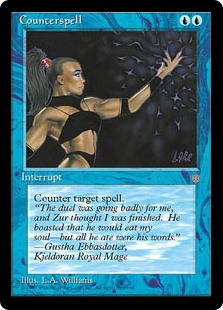 Counterspell 3.5
Counterspell 3.5
This should have an errata to being called Actual Counterspell to differentiate it from the effect. This is a card I love much less than most people and not because I don't like countering peoples stuff. It is more because I think the effect is overrated. It is very good but people seem to fear it far more than they should. Intrinsically the effect is decent but not over powered, it is the way in which people play wrong when faced with the possibility of counter magic that shifts it up a power level compared to other disruption and removal. There is nothing I like less than dying to some random dork that snuk in before you ripped your Counterspell that managed to then get in 5 times while your helpless to do anything to the board with your counter magic. For this reason I tend to play few counterspells in a control deck, 6 in a 40 card deck would be a lot in my books. I also like my counterspells to offer me some extra utility. Arcane Denial, Remand, Cryptic Command and Mana Drain each offer something Actual Counterspell does not. As I like to have a reasonable spread of one, two and free counterspells and as Actual tends to come in 4th favourite of the two slotters it doesn't often get slots in my decks unless multiple decks are fighting over the cards. Counterspells have got worse in general as magic has aged and more spells get around them, cascade, flashback and so forth. They cannot be relied upon as your only answers and should be treated a little more like black discard. Good as a way to get a few problem cards out of the picture before they do any damage and good as a way of throwing a spanner in the works of what your opponent is up to but not something to rely on to lock someone out of the game or solve every problem. If you build a deck with too much counter magic you will just end up losing to awkward things like the Goblin Guide that came out before any counters were online or the man land or the Bloodghast etc etc. What people always seem to forget about counter magic is that it is very restrictive to always keep yourself safe with it, it makes you unable to spend your mana as you might like and this is easily exploitable. When playing around counter magic you should always try to spend all your mana, playing around counter magic does not mean not casting your spells, it means using your mana more efficiently than your opponent, exploiting the weakness inherent to their strategy. This not by holding back spells but by throwing the less relevant ones out into the more blatant counterspells, it is done by casting more cheaper spells over fewer big powerful ones and by investing mana into abilities already in play to get you further ahead. This can be as simple as getting in for a cheeky three with a Treetop Village on turn three or four instead of dropping down a key card like an Ohran Viper. It is hard to lay down generic rules for how to play so that your opponents counter magic works against them as a lot depends on very subtle things. My point is more that you shouldn't feel intimidated by counter magic, you should see it as a potential weakness to be used to your advantage. Tangent over, Counterspell is the Boomerang of counterspells, it is cheap, effective, reliable and only demands a little more blue than the others for its perks. It is a card that scales well into the game and offers a lot of security and potential power.
 Mana Leak 1.8
Mana Leak 1.8
Power 1.5
Support 2.3
I hate this card and only ever play it if I need another two drop counterspell and have no access to any others that are suitable. It is great early in the game but pretty much dead in the late game. In the mid game it can be dead and is easy enough to play around. As counters that get worse as the game goes on I would always rather play a Force Spike or other one mana spell. While I am biased against this card I do dislike it more than is reasonable. Most of the time it gets the job done as well as counterspell and sometimes better. I have often toyed with swapping this for Miscalculate as cycling nicely offsets the problems with the card. The difference between having to pay two and three mana is pretty significant however and means that Miscalculate starts to fall off in power level far too quickly as the game goes on. I have a strong aversion to cards that are unpredictable in what they can offer you, I also have an aversion to playing cards that can dead. On top of this I don't like playing very heavy counterspell counts in decks and even if you love Leak you cannot claim it is in the top 5 or really even that close to it. Taking all this into consideration despite my overly biased opinion on this card you should avoid playing this where possible but will rarely suffer any disappointment when you do. Mana Leak is fairly good to play blind unlike cards like Mental Misstep, Negate, Spell Snare etc as it is so broad. It is a reasonable filler counterspell and will make up the numbers and do so well regardless of what you are facing.
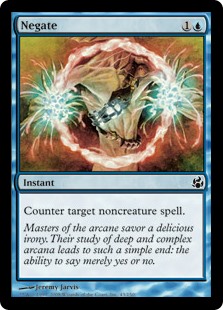 Negate 2.1
Negate 2.1
Power 2.2
Support 2.0
Negate is a fine little card that is just the ticket in a few decks. While it is not a broad as Mana Leak it scales far better into the late game and is harder to play around. You are happy to play Negate blind as it will have targets in every deck. Agro decks have the least targets on the whole but they tend to be the most important things to stop such as planeswalkers and equipment. Typically you play Negate when you know what the things are that you want to stop such as an Armageddon. Combo decks for example rarely need to stop dorks as they can race them easily. Green based multi colour control decks also love Negate as they are less able to support the heavy blue requirements of actual Counterspell and don't have any problems dealing with dorks in play. Despite its similarity with Spell Pierce they end up performing very different roles. You play Negate when there are things you reliably want to stop that ruin you if you don't, you play Spell Pierce when you want some added cheap disruption. Negate is consistently decent throughout the game while Spell Pierce is much more powerful in the early game and then starts to sharply fall off in power level. This simple difference leaves this similar cards rarely competing for slots and performing very different applications in often dissimilar decks.
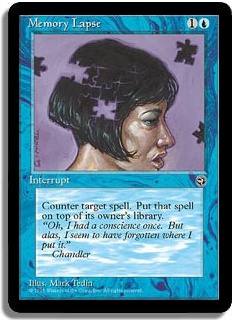 Memory Lapse 2.0
Memory Lapse 2.0
Power 2.3
Support 1.8
This is not unlike Remand although sadly not quite as good. It offers the same overall card advantage and requires the owner to recast the card. It also costs the same mana and can be more brutal than Remand if they need to be drawing lands. Lapse will almost always delay the spell by a turn which Remand does not do nearly as effectively as the game progresses. I also find Lapse to be one of the better cards to have under an Isochron Scepter due to how it forces them to play. Why then does Remand tower so far above Lapse in power given their similarities and the few advantages just mentioned of Lapse. As neither actually deal with something they are tempo based disruption cards and not pure counterspells. When you are trying to gain tempo through such effects it is because you are aiming to win the game later on, otherwise you would have a more proactive card in the slot. Drawing more cards, especially lands and things that do more than go one for one is how you win games that go on longer in magic and as such the fact that you don't lose a card when you play Remand that makes it much more what you want from these cards. Remand helps you to get where you want to be. The difference between both players losing a card with Lapse or neither player losing a card with Remand works out greatly in favour of Remand simply due to the role the card fulfils. Lapse is not a bad card in the role of Remand but requires your deck to have a very consistent mana base (making drops rather than fixing colours) and a higher quantity of card advantage. Also probably the best pseudo-hard non-alternate cost counterspell for combo decks. This means it substitutes for Remand sometimes and finds occasional play in preference to Remand or other disruption / counter magic in Scepter decks, mana denial decks and combo decks. You will get the odd free win playing with Lapse but for the most part it will just feel like a very ineffective counterspell. You should expect it to seem worse than it actually is however this is still not good enough to get overly excited about.
This golden oldie is not without competition for its slot however much like many old cards, the simplicity and elegance of this card is its strength. It his all permanent types from both players while being instant and only two mana. It has no added frills but fulfils its primary role more reliably than any other bounce spell. The main reason Boomerang has remained so competitive is that it can hit lands, of which there are many good targets in the cube. Lake of the Dead, any of the bounce lands, even Shelldock Isle and man lands are really powerful things to hit. In the same way that Vapour Snag is as good as a Swords/Path in a good number of the games you use it Boomerang is as good as a Sinkhole relatively often. Being able to have powerful tempo effects on the early game is something blue is more than happy to pay card advantage for, especially when it comes with so much added flexibility. It is generally the best bounce spell to have under an Isochron Scepter and despite its lack of excitement is a really hard card to cut from the cube. Double blue to cast can tip the balance in favour of cards like Cyclonic Rift for the slot in a deck, more heavily for more colours rather obviously. You tend to find the Boomerang more often in heavy or mono blue decks which have no trouble casting it on turn two and less ways to keep early tempo parity. Agro decks often favour Boomerang to other bounce as it always gives you the option to spend your mana on turn two even if you lack threats and they haven't done much beyond making lands. Staying proactive is more important to them and so Boomerang is the least damaging to include.
 Cyclonic Rift 2.6
Cyclonic Rift 2.6
Power 2.5
Support 2.8
Since its recent entry into the cube this has become one of the most commonly played bounce effects in the cube. I fulfils the roles of cheap instant tempo based disruption that can deal with most targets at the cost of card advantage. This gets is play in lots of control decks as well as some combo decks. It has even wound up in the odd agro deck and unbelievably has been usefully overloaded while in them... Rift has its drawbacks, it doesn't hit lands which makes it awkward against man lands and unable to give you brutal starts against early bounce land play. It also can't target your own things which is more annoying as an agro player and less relevant as a control player but does reduce the scope of the card regardless. You rarely want to bounce one of your threats just to save it from removal as recasting it will set you well back in tempo but when you do want to it tends to keep you in the game. The upside of Rift is that when you have the mana to be bouncing and recasting threats happily you probably have mana to overload it at which point you are very glad it only affects things not under your control. The overload can be utterly devastating and is fairly comparable to a one sided Planar Clensing. It will either win you the game in short order or buy you a few valuable turns. As such the range on this card is one of the greatest in magic, at one end of the spectrum it is highly versatile cheap low impact disruption while at the other end it is a huge game changer you can base a whole game plan upon.

Daze 2.5
Power 2.6
Support 2.4
Daze is probably the best generic free counterspells after Force of Will. Mental Misstep is the more powerful card but fulfils a very specific role and so is not a good comparison. Few counters are good comparisons for Daze however. Force Spike is a great card and the mere threat of it makes people play differently. Daze has the same effect but is more harmful to play around due to it not needing any mana to play. Both Daze and Force Spike spend their time divided reasonably evenly between being a cheap hard counter on exactly what you need to being totally dead to being able to counter something just to get use from the card rather than because you couldn't beat the card. As previously mentioned the threat alone of these cards gives you an advantage so even when dead they sort of haven't been. They do spend more than their fair of time share exiled due to Chrome Mox and Force of Will. The normal cost on Daze is still cheap and is used much more than Force of Will uses its alternate cost. This is pretty reasonable as the alternate cost on Daze is most often worse than that of Force of Will early in the game. While it is no card disadvantage you have effectively destroyed one of your land which blue above all colours hates. This will set you back in tempo and can easily cost you the game as a result if in a control deck. The alternate cost becomes much more comfortable from about turn four onwards but by this stage Daze is far less likely to be countering stuff. If your deck can cope with having weak cards (ie lots of card advantage or quality) and also recover tempo well then Daze is fantastic, if not then you need to really consider if it offers you what you need. Daze does have some good synergy and utility outside of its main function such as to turn on Land Tax or to get a land for Foil. Most commonly played in aggressive fish or skies blue decks but cropping up reasonably often in all kinds of decks from UG Opposition to UW control.
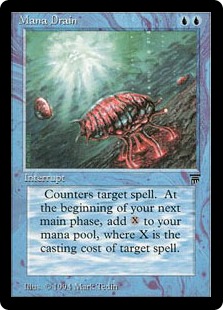 Mana Drain 4.5 (Now a banned card)
Mana Drain 4.5 (Now a banned card)
Power 4.8
Support 4.3
Playing mana burn rules in your cube does not do anything to balance this unfair counterspell. Mostly what it does is counter some reasonably powerful and good three drop and then untap and make a threat, usually with counter backup. Whether it is a planeswalker or a Wurmcoil or just a meagre Simulacrum it is such a swing in the game state that you win off the back of it most times. Mana Drain is often a proactive counterspell which seems kind of oxymoronic. You find you just want to counter any expensive spell simply to gain the mana ramp if you have things like the afore mentioned Wurmcoil in hand. Mana Drain is probably one of the cards responsible for winning most cube games. Actual Counterspell is plenty good enough and then Mana Drain comes along and spoils loads of games before they have really got going. You should pick up cards like Solemn Simulacrum and Divining Top as great mana dumps if you have the Drain (especially if you play mana burn) but if not, play it any way and don't worry about it at all. It will be winning you way more games than it causes you any harm compared to Actual Counterspell or most other cards...Force of Will is a better counterspell not because it is more powerful as it clearly isn't. Force of Will does its single specific role of countering spells better than any other card. Mana Drain on the other hand counters spells pretty darn well while also doubling up as one of the best mana ramp effects in the game. A cautionary tale regarding careful card reading; I recently threw a game in the modo cube despite having mana drain. I was mana screwed with a silly ramp deck having only 5 open to me and needing 8 to get going with my Sundering Titan. As things were rapidly going sour I decided my only chance was to cast my Timetwister and then Mana Drain it so as to have 8 mana next turn and flop out my fatty. Foolishly however I did this in my first main phase and so got a fairly useless 3 mana back right after combat... I have now removed the Mana Drain from my A cube and put it with the likes of Fastbond, Black Lotus and Sol Ring in the banned box. It exactly fits the bill of a card that doesn't improve the game. Its power level is unreasonably off the chart making it swingy in its own right and it also comes with that free win feel when you counter something decent and have exactly the right things to use that mana on. It rewards the lucky more than the skilful and can single handedly win games which is not really what you want from any card, let alone cards that are perfectly decent in complete isolation.
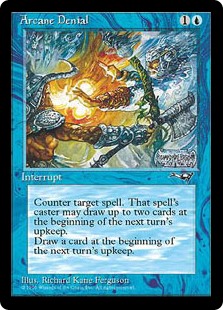 Arcane Denial 3.8
Arcane Denial 3.8
This is one of my favourite counterspells. Nothing says easy to cast hard counter like Arcane Denial. Unlike many other counterspells it is also dual purpose which given the versatility of counter magic already is quite extreme. In mono blue decks it may be fair to say that Actual Counterspell is a better card however I am not 100% convinced of this as I shall come to explain. Unlike Actual Counterspell, Remand and Memory Lapse which all retain card advantage parity with the other player Arcane Denial will put them a card up on you compared to before you cast it. This may seem terrible for a control deck to be giving away card advantage however in my experience it is rarely an issue unless playing against a deck like red deck wins for which you have to use the card differently. Like Remand you get to draw an extra card early in the game which greatly helps control decks to stabilize. The loss of card advantage in this early stage is overcome later on by cards like Wrath of God and planeswalkers which you are much more likely to be able to cast as you have both disrupted your opponent with counter magic while also drawing extra cards. Some combo decks using this card also don't care in the slightest about donating extra cards to the opponent a little like Goblin Guide as the game will be well over before they are relevant. Arcane Denial is also the best counterspell to splash along with Negate as it says no to anything for just one blue. When you need to counter a spell such as Armageddon or lose as a result losing card advantage is an easy sacrifice to make. Finally onto the reason this card is never dead, even when you really don't want to gift your opponent a pile of cards. If you counter one of your own spells all of the card draw effects target you meaning you get to draw three cards at the start of the next upkeep. This is not quite Ancestral Recall as it is two cards and two mana plus whatever the card you countered cost however it is still card advantage and good card quality. Throwing away things dead late game such as Chrome Mox or avoiding being put savagely behind from hand disruption is a fantastic secondary use for the card. I rate this as the fourth best counterspell of all time and it is pretty close to Cryptic Command at that too.
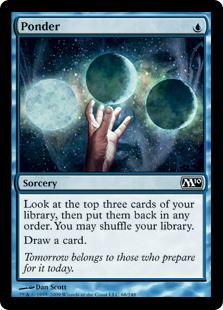 Ponder 2.5
Ponder 2.5
Power 2.4
Support 2.7
I don't much like any sorcery speed cards in control decks that do not effect the board position. This is not a view held by all players and leads to Ponder and friends getting play in all the flavours of blue deck. As blue has few one drop monsters the one mana cantrip cards are quite useful in tempo based blue decks as they allow you to play fewer lands and only the best low drop cards yet still have a good chance of curving out with them. It is in combo decks these cards shine the most as they are very cheap, replace themselves (thus reducing the size of your deck effectively and therefore making you more likely to draw what you need regardless of the library manipulation) and dig effectively at least 50% deeper into your deck due to it being 40 cards not 60. When you are only after card quality and have no need of instant speed with few shuffle effects Ponder is vastly superior to Brainstorm. You can see up to 4 cards which is more than any other cantrip one mana card quality spell and it is an optional shuffle too. Although Preordain is the better card it is very very close and the two swap around as to which is best in situations and decks.
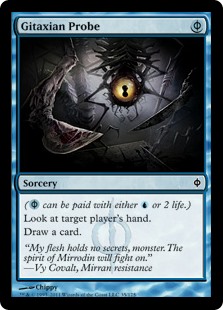 Gitaxian Probe 1.9
Gitaxian Probe 1.9
This is a card I threw in the cube to test out but had no real ideas in mind for it. This is unsurprising as the card is very low impact however it has cropped up in a wide variety of decks often enough to keep its slot even though it hasn't become a mainstay in any deck. Given that the card is pretty painless to play in a lot of decks it is just occasionally exactly what you need to finish off a build while keeping the right mana ratios etc. A lot of the time two life is irrelevant and on the times it is not the one mana cost is hardly troublesome unless played off colour. Looking at peoples hands is an effect that is very hard to place a value on because it depends on so many factors, many of which are outside of the normal considerations for cards. It is good in control and against it, it is good against un-scouted decks but it is much less use against players who broadcast their intentions. Essentially if you can get good reads on your opponents anyway you may be better off playing a Ponder or an extra land. Looking at peoples hands is useful if probability is not a strong suit of yours as well which is another unusual yet worthy consideration to make. The nice thing about Probe is that the cost is right for an effect so difficult to pin value to and so it will never really damage you and may well completely save you. I am very happy to play this in any deck with some blue without any other synergy and I become more keen on the card the more it is supported. It is a card a lot like Chromatic Star in that it is very painless to add to most decks and has some pleasant synergies to offer. Simple things like Grim Lavamancer or Snapcaster Mage become more useful more quickly with this kind of spell in your deck. Cards like Cabal Therapy become easier to use and storm counts can be easily raised. Some of the narrower cards like Illusory Angel become more playable with cards like Gitaxian Probe easing them out. Probe is a very interesting and broad card that offers lots of options yet is still one of the harder cards to place a value on. Suffice it to say I wouldn't be without one in my cube, but then I am very partial to cards that iron out some of the luck based flaws in Magic.
 Preordain 2.6
Preordain 2.6
Power 2.5
Support 2.8
Ever so marginally better than Ponder as you can use it to keep only one card that you see without need of another shuffle or scry effect. Ponder may search a card deeper but it does not allow you to set yourself up as well in general which is what you are trying to do in the early turns. The two cards offer nice redundancy to each other and are so similar you are generally happy with either. The best way to shed light on why Preordain is better is when you have a land light hand and would cast one of the cards on turn one. Lets say you see one land and the rest cards you have an easy choice with the Preordain where you put the non-land to the bottom and take the land. With the Ponder you are likely best of shuffling and hoping to hit 2 out of 3 lands in your next three cards which can leave you more screwed. It is much more frequent to need several things at any point in a game of magic than it is to only need one specific card. Ponder is therefore better less often. Best in combo but fine in more agro decks, more due to blue being thin on top rate cheap dorks than anything else. I still try to avoid playing these in control decks always preferring to be able to spend as much mana as possible at instant speed. A control deck can still do an awful lot in the cube with a single mana ranging from countering most spells to removing most permanents.
 Mystical Tutor 2.3
Mystical Tutor 2.3
Power 2.5
Support 2.2
Likely the second best in the cycle of these tutors as instants and sorceries make up a good portion of answers, outs and combo pieces. Being instant and only one mana makes up for the card disadvantage a little and prevents too much tempo loss from use. Tutors are great in singleton formats as I seem to say rather too much. This aside I tend to avoid playing it in control decks as I dislike the card disadvantage but it does allow you to play less redundancy and fill those extra slots with powerful cards and extra card advantage. I think it comes down to preference more than anything else but I tend to find I need to use my tutors to recover from bad situations rather than to get ahead and as such the card disadvantage is much more crippling. Agro decks have very little use for such cards and on the other end of the spectrum the combo decks adore them. Having Mystical Tutor as well as lots of card draw and card quality makes blue the best colour for combo decks although black is close behind. Even when I am mostly after instants and sorceries with my tutors I prefer Vampiric to Mystical as if it not uncommon at all to just need lands. With combo having had a real lull over the past couple of years this has seen very little play despite being a key card in lots of different decks. It now offers some very nice synergy with miracles however it works far better with the ones that are not blue making such plans a little less commonplace. I feel this cycle of Tutors is very well balanced and designed and sits just right in terms of power level.
 Vapour Snag 2.8
Vapour Snag 2.8
This is a recent addition however Unsummon would do the job just as well. The addition of Snapcaster Mage as well as more creature based and tempo based decks being built has made cheap effects like this much more desirable. The one life loss is largely irrelevant and is a drawback about 5% of the time as you want to bounce your own guys. This does make me wonder if I should just dig up an Unsummon as with many blue decks (which have little life gain and are often slow) the value of your life is much higher than for other colours. With the speed and power of the cube Snag actually ends up being better than Path or Plow around half the time. If they never get the opportunity to recast the thing you bounced you have had one mana removal with a bonus rather than a drawback! Blue simply doesn't have much it can do to impact the board on turn one short of having the appropriate counterspell, which if you are on the draw can only be Mental Misstep. This makes Snag a valuable asset in blues early box of tricks. It is one of the narrowest bounce spells in that it can only hit dorks however it is being played in a different capacity to most other bounce where it is all about costing just the one mana. Most control and agro decks containing blue end up playing the Snag, those with white and black far less so than those with red and green. Snag is at its best in UR agro decks where it compliments cheap burn both as removal and as a finisher.
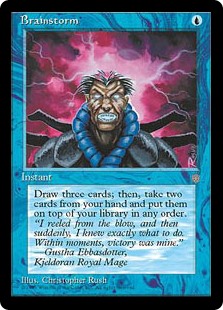 Brainstorm 4.0
Brainstorm 4.0
Power 3.7
Support 4.4
Many people both overrate and misplay this card. It has many applications and offers great utility, card quality and trickery complete with valuable and hard to find library manipulation. Unless you have specific uses such as an Erratic Explosion deck Brainstorm requires you to have shuffle effects in your deck to be better than Ponder or Preordain. This is easy to achieve with things like sac lands and you can get away with about three or so. I see so many people cast a brainstorm the moment they have a spare mana to do so, often on turn one which is usually a big waste. Much of the power of the card lies in getting rid of the cards you put back on top and so waiting till you have both a shuffle effect and cards you don't really want is optimal. As I write this we are on the verge of miracle cards which will primarily serve to make this a much more valuable card. I have adjusted its rating up a little in light of this new mechanic but suspect I have been overly cautious. Another key use of Brainstorm after miracles and shuffling things away for pseudo Ancestral Recalls is getting protection from hand disruption whereby you can hide key spells on the top of your library to play later in the game. This is another reason to save the Brainstorm and not insta cast it. The final use of the card I have touched upon and it is simply getting cards from your hand into your library which in singleton formats is important for quite a few combo decks such as Oath of Druids and Tinker. While powerful the card is well designed, well balanced, subtle in effect and rewards the skilful player. Cheap card quality enhances games and makes for results that are based more on skill than luck of the draw. Brainstorm is a common favourite among magic players and deservedly so.
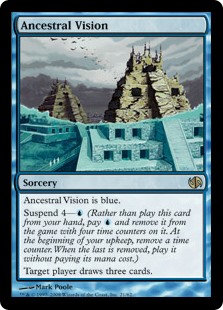 Ancestral Vision 3.6
Ancestral Vision 3.6
Power 3.7
Support 3.5
One of the most potent and efficient draw spells in the cube. Typically control decks are playing less pure draw spells and more cards that cantrip early and things like planeswalkers to effect the board and gain card advantage later on. Only the very best pure draw now remains and this is one of the lucky few. Costing only one mana is pretty negligible at most points in the game and may not be disrupted at that point. It can be annoying as a sorcery if you have something like a Force Spike and having to make that choice. I usually find getting down your Visions at the earliest opportunity to be the correct play. The delay in getting cards is obviously a bit annoying but still worth the wait. I have not seen too many people die with this still suspended. The problem with card draw in general is the investment of mana needed to do so which offers no advance in board position and so the delay in cards from visions is more than offset by the freeing up of mana to allow other things to be played. It is a little vulnerable to being shut down by cards like Aurelia's Fury and Abeyance and while that may feel devastating you haven't actually lost that much as a result, certainly no mana disadvantage. Under most normal circumstances you have to pay at least four mana to get a straight up 3 for 1 in the cube and Visions does it for one mana and very little fuss. Really saucy in combination with cascade, most notably Shardless Agent, but not without its nombos with other cards. Snapcaster Mage is unable to reuse this effect (thank god). While control is always happy to invest the one sorcery speed mana and the turns to get the bounteous rewards and many agro decks will run the risk of getting it down early enough to be relevant combo decks play it far less often than most other draw spells for the obvious reason that they are all trying to go off faster than 4 turns.
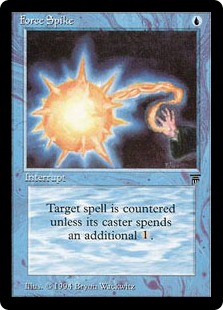
Force Spike 3.5
Power 3.6
Support 3.4
One of the most painful ways to lose a game is to a Force Spike, so much so that it often does more for you when you don't draw it. Nothing makes you feel safer when you are a control deck than starting off a game with an Island and have a Force Spike to back it up in hand. Many of the other options for one mana counter magic are more cost effective or situationally more powerful however none are as all encompassing as Force Spike. It can hit any spell and is guaranteed to stop it if they are curving out in the early stages of the game. While one of the best cards to have early in the game it is one of the weakest late game cards for blue, this is the colour to be a dead card in with many ways to get value out of useless cards. It is also the colour to be a really powerful early play as blue lacks ways to get involved in the game in the early stages. If you know the sort of things your deck is scared of or weak against you can tailor you suite of one mana counter magic should you deck desire that sort of technology. If you are lacking information on what you are likely to face you can't go far wrong with Force Spike as something to give you more early game. I have previously mentioned I keep a bit of a tally as to what cards seem to be the hinge card that ultimately swung the game one way or another. Force Spike is very high on that list and is one of the cheapest spells on it too. It wins you games when you have it, it wins you them when you don't and it is the card Mana Leak wishes it was. Counterspell is the more powerful and more iconic card however Force Spike performs a more important role for blue in an area less well catered for than Counterspell. You feel ripped off when you get your Goblin Guide countered by this but you feel even more ripped off when you get your Elspeth countered by the humble Force Spike.
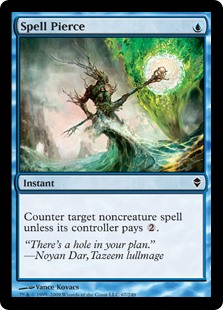 Spell Pierce 3.4
Spell Pierce 3.4
This is one of the most reliable cheap counters as it is crippling to play around unlike Force Spike, Daze or Disrupt which are manageable to evade for key cards. Not hitting creatures makes it a bit weaker against some of the aggressive archetypes than Force Spike but against any deck with 50% or less creatures it is one of the best counters you can run. It is rare for a game to go on really long and people have enough mana that it is actually dead like Spike, Disrupt and Daze easily become in the first 6 or so turns, which are vastly more important than the later ones. It is as good as a one mana Negate throughout the midgame. The popularity of planeswalkers makes this a better card too as it will be able to to deal with some of the more serious threats in most kinds of deck. This is the third best counterspell to be printed since Force of Will after Remand and Cryptic Command and has been performing outstandingly when selected. Cards like this allow you to play valuable comes into play tapped land like Celestial Colonnade much more comfortably as you can still keep up reliable counter magic while making early tapped land instead of holding them till later and not being able to cast an expensive spell when you need to. Even against the decks it is weak against which have 10% of the cards or less as viable targets it is still rarely dead and might sit in your hand a bit longer but will eventually trade efficiently for some card you would rather not have to cope with. Spell Pierce has the nicest blend of wide application without tailing off too much in power level as the game goes on. Force Spike is the more reliable card for early game control but Spell Pierce is far less likely to be dead and needs less in the way of filtering effects to support it.
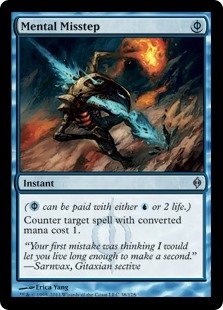 Mental Misstep 3.0
Mental Misstep 3.0
Power 3.3
Support 2.8
When you are on the draw there are few cards that make you feel safer in your openers. Almost every deck plays one drops and some of the most powerful cards cost a mere one, not to mention one drops being one of the most common of any converted mana cost in my cube (along with two). Blue is generally most vulnerable early in the game and being able to set up or counter multiple things without losing card advantage is a real help. While remaining a hard counter throughout the game it does lose value as time progresses as the things it counters start to impact the game much less. Stopping the turn one Llanowar Elf is game winning, stopping the turn six one is marginal. It tends not to see play outside of blue as other colours are less afraid of early drops but it does get brought in lots from sideboards to deal with specific things such as a Path to Exile, Reanimate or Goblin Welder. Sadly it is a little like one of those cards that depends a lot on what you are up against which detracts from its neat design. At least being blue there are lots of good ways to get use out of somewhat dead cards. A great card that should be very actively moving between your main and sideboard if being used correctly. One reason for this is that it is stronger relative toy our other cards when you are on the draw compared to say Force Spike which is superior when on the play. It is a card you need to think long and hard about why exactly you are playing it and if you can afford to. When you get it right it will be one of your best spells and when you get it wrong it will do a whole pile of nothing.
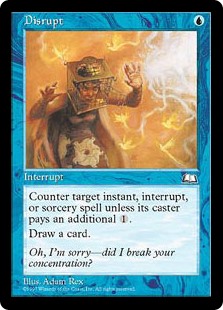 Disrupt 1.0 (B cube)
Disrupt 1.0 (B cube)
Power 2.6
Support 0.4
This can be the most unfair of all the one mana or less counterspells as it cantrips, which usually costs 4 mana or offers some cards to the opponents as well. Sadly it is also the most situational of all the counterspells in the cube hitting significantly less than Spell Pierce. Many decks have very few instants or sorceries and by their nature it is reasonably easy to play around disrupt with instants. On top of the limitations on targets it is the softest kind of counter you could imagine and is easy to avoid once it is on someone's radar. The upside is you can cycle it later on when there is no chance of stopping any spell. The bonus of drawing a card and being easier to get value from later in the game does not compensate for the limitations on targeting. One mana counterspells are played so as to keep the early tempo under control so that you can win later on with more effective cards. Disrupt is weaker at what you want it for and better at things you can achieve more effectively later in the game. As such Disrupt tends to only be brought in when you know it has lots of targets making it rather a hoser card. There are just too many potent one mana counterspells that have a much broader application than Disrupt for it to deserve a main cube slot. It is at its best against very counter card draw control decks and against black hand disruption. Some combo decks also find it annoying however sill probably less so than they find Force Spike. I cannot imagine many situations where I would want to main deck this card however it remains one of my personal favourite counterspells.

Spell Snare 1.4
Power 2.2
Support 1.0
Comparable to Mental Misstep in that it is great on the draw and better in the respect that it hits more powerful cards so does lose value as much as the game progresses. It also tends to have a more consistently high number of targets across all archetypes than Misstep does, some decks can have as few as a couple of one drops where as I cannot think of any good deck that would have less than 4 two drops, most with many more. Snare has no alternate cost to guarantee its slot however but will at least always net you a mana advantage without a life cost that is needed for Misstep to do the same. Spell Snare struggles to compete with more reliable counterspells that do not have their power level determined solely by what the opponent is playing. Despite more targets than Misstep it is more the case with Snare that you cannot really say your deck will benefit from it with no information about what you are facing. You can look at a deck and know that it will be weak to turn one plays and therefore reasonably include Misstep blind. If your deck is bad against two drop plays you should really start again from scratch rather than hoping Spell Snare will save you. Blue easily has enough depth to support two counter style control decks and when it is required to do so cards like this become much more interesting and valuable. When you have basically got free reign on counterspells this is a little to niche to get slots over more reliable cheap disruption. The main thing wrong with Spell Snare is that it is a one mana counterspell that when you are on the play does nothing against a one drop from your opponent. While Snare is really rather good on the draw and very powerful in some matchups such as Isochron Scepter decks it is not a card you would ever want blind and on the play. As such it should be much more of a card you use from your sideboard to fine tune within a match.
Power 4.2
Support 2.9
I had this guy down as the best planeswalker in the cube for a long time. It is more the result of him only fitting in certain decks that tend to have a very high overall power level that Tez shines so much. Typically he gets cast on turn three, untaps some artifact mana and casts a time walk immediately which is then followed by using his ultimate for the win. His ultimate is the most used of any planeswalker in the cube. In many ways he does what Garruk Wildspeaker does yet while costing more mana he still tends to be quicker than Garruk, if not as useful in any old archetype. Typically untapping two artifacts will net you a lot more mana than two lands and you can get more artifacts into play quicker than you can dorks as well as them being more likely to all still bei n play in time for your ultimate. Tezzeret works well in big artifact mana decks, an alternate win mechanism in affinity or a tutor effect for combo decks using artifacts such as Sword of the Meek + Thopter Foundry or Painters Servant + Whetstone. While being the most restricted walker Tez still shapes up very well for his overall power and synergy. As soon as you have a critical mass of artifact mana sources and cheap aftifacts Tezz quickly becomes the most powerful planeswalker. He has much more immediate impact than any other walker and is able to use his ultimate to lethal effect more quickly and reliably than all the others. Obviously like Upheaval and some other cards he is of much higher power in cubes with Sol Ring and the other artifact power cards yet he is still abusive in the right deck, jsut the cards for those decks are not as abundant or as overly powered.

Gush 2.4
Power 2.6
Support 2.3
Whenever a spell can be cast without mana it warrants much looking at. The alternate cost on Gush is savage in some decks or in some situations while beneficial or at least harmless in others. This is made up for to some extent by a fairly reasonable standard cost and by being instant. With Library of Alexandria Gush was especially useful in refilling your hand very effectively while not giving your opponent a new grasp of seven as well. Now its best use is for powering up Foil. While its best use may be minor it is a versatile card that offers lots of trickery to its wielder and can see play in all kinds of decks. Most commonly these are aggressive decks using evasion monsters to curve out and full of free disruption to back them up. Gush helps power out these threats and disruption, the latter of which often cost card advantage to use. Numerous combo decks have put Gush to use, some actually able to generate mana with it in Fastbond style decks of old. Control is the least common place to find a gush as they rarely want to lower their land count but it does provide unique options for them and is fine as a card to pitch to Force of Will etc or just hard-cast late game at the end of one of their turns in which you didn't need to counter something. Gush is a very neat little card with some great applications and synergies. It does not have the most raw power but ticks all the right boxes while being unique in design as well meaning no real alternatives ensuring it a cube spot for the foreseeable future. Gush is one of those few cards that is able to find a home in agro, control and combo when it works with what they will be doing.

Thoughtcast 1.9
Power 2.3
Support 1.6
Less narrow that many of the affinity mainstays this card is still only playable with a high artifact count. At three or more mana to play you are falling way short of the power level required of cube. The sorcery aspect of this card is not too significant as you are aiming to cast it for one which is so little you would rather have the extra options from drawing in your turn than leaving mana open most of the time. Pure draw cards don't often find their way into beatdown decks as they are not an investment that provides tempo. The main exceptions to this are Thoughtcast, Gush and Ancestral Visions/Recall simply because the cost is small enough to play them that tempo loss is not much of an issue. The worst part of this card is the fact that is always needs a blue mana and would likely be much more exciting as a 6 or 7 mana colourless spell. Often this card causes damage to your tempo as you don't have access to blue. It requires careful mana base consideration as well as artifact count and costs for Thoughtcast to be an option however when it is it becomes and auto-include whatever your deck is.

Force of Will 4.6
Power 4.6
Support 4.6
More than any other question most games in the cube end with; Force of Will? Free counterspells are great offering tempo gain and the opportunity to be more proactive and Force of Will is leagues ahead of the others. Being a hard counter that only costs you one card to pitch cast with a playable standard mana cost makes this an auto include in almost any deck with enough blue cards to pitch. You don't even need to be running lots of card advantage to make back the cost of this spell as it is just so reasonable. Exiling a card rather than discard can be annoying in singleton formats for combo and control decks as the cards they often most want to pitch early are the most important cards in their decks for winning. Nothing makes you feel safer in magic than sitting on a Force of Will and some situational cheap spell to pitch like a force spike. The bannings have made the best cards in the cube much closer in power level and this is one of the strong contenders.
Power 3.3
Support 3.1
Tamiyo is a fairly solid all round walker. She is probably less effective than some of the more expensive versions of Jace however with their already being two versions of Jace in the cube the ability to play Tamiyo comfortably along with the others is very significant. The Memory Adept being the same cost equivalent as Tamiyo is the main competition. The Adept is a better threat and a more reliable mechanism to draw cards however lacks the important aspect of self protection the best walkers offer. If you lay Memory Adept on to a stable board you will quickly bring the game to a close in your favour however if you are at all behind when you make Adept you will probably have spent 5 mana to gain 5 or 6 life and draw one or two cards which is OK but not great, especially as when you most need the life you opponent will just ignore Jace and hit your face instead. Tamiyos greatest strength is in her ability to protect herself which she does better than any other blue walker. Gaining loyalty and simultaneously locking out a permanent of your choice makes it very hard to kill her even if you are ahead. The versatility on the lock out allows you to easily claw your way back from being behind and then engineer your own advantages by stopping their attacks, then locking out their important colours and then moving blockers out of the way. The +1 on Ajani Vengeant compared Tamiyo is awful and really fails to do what you need it to as it doesn't tap as well as preventing untaping. It gives you far less security and flexibility which makes Ajani the weaker walker. Tamiyo and Ajani are a good comparison as well for their other abilities, the ultimates take as long as each other to power up to and rarely get used, and they both have a powerful -2 effect that you are unlikely to get more than two shots off with. With these walkers I find I use them up to get lots of effect rather than trying to win the game with them or keep them in play for options. They are too hard to ramp back up if they take hits and don't really do enough for their cost if just treading water doing +1 and so to get value you often sac them off with the -2 effect. Drawing a card for each tapped creature can be minor or ridiculous depending on what you and your opponent are playing. Unsurprisingly Tamiyo is at her best in creature based decks facing down other creature decks as it gives you the most potential to get a cheap hand refill. She is fine in control as most walkers are and is often able to activate the -2 more in control than in agro but overall average about the same amount of cards drawn total. Drawing two is pretty powerful and easy to engineer and much more than that becomes fairly serious. The ultimate is extreme but rarely comes into play like most ultimates. It is also very dependant on what your deck does, in a counter burn deck it is insane, the ability to cast Lightning Bolts non-stop is hard to lose with. In very heavy creature decks, particularly mono blue decks you have few spells that are either bounce, counter or draw which are not the easiest to abuse with repeat casting although certainly game winning if it goes on for a few turns. Tamiyo is a good all round walker of a fair and balanced power level. She is no Mind Sculptor but she compliments him well and fits more comfortably into decks than either Memory Adept or Architect of Thought.

Treachery 4.0
Power 4.1
Support 4.0
If they have no sacrifice mechanism or no counterspell then Treachery is a total wreaking. Getting to remove their best guy and get it for yourself at no mana cost is about a big a swing in Magic as you can hope for. Treachery, when working as intented is card advantage, tempo advantage, removal, and a threat. If they do have a way to fizzle the spell and thus negating the land untap paying five to bait a counterspell or kill a guy, even in blue, is far from a bargain and the loss of tempo from which can be fatal. This is the infrequent worst case scenario which is easy to play around. Best cast scenario, which is most of the time you hit five mana and expend one card and an average of one mana to kill their best guy while getting one for yourself. Even if they untap and immediately kill the Treachery you have gone one for one on cards, gained mana advantage and caused them to lose attacks. Treachery is hard to deal with as it is an enchantment and often requires them to kill their own guy giving you that great two for one feeling. The mild downside of this card clogging up your hand until you hit five mana is least problematic in blue with much filtering, pitching and reshuffling effects to smooth things out. A strong contender for any heavy blue deck, control or agro. It is weakest against goblins and affinity which have primarily small creatures you are not too exited to steal, as well as both decks having a great number of ways to instantly sacrifice dorks and fizzle your untapping of lands.

Fact or Fiction 3.4
Power 3.6
Support 3.3
An outstanding card from many perspectives. It gives your opponent the chance to make mistakes, offers interesting choices to the caster, digs deep into the library for when you need a specific spell, costs only one blue mana to cast, is instant speed, guarantees three for one card advantage at worst, fills up the graveyard and just so often causes someone to scoop in favour of dividing up three or more things that beat them. The instant is the key aspect of the spell making it playable in control with four mana being a risky investment to make in a main phase. Its cost makes it compete with other very appealing spells and rules it out as an option for some combo decks and high agro low mana curve decks. Still, this is about the most all round card draw spell in the game after Ancestral Recall offering a good quantity of cards for a reasonable cost with no stipulations or real drawbacks all rounded off with the essential instant speed to offer the complete package. The few slight drawbacks you could accuse this card of are danger of losing vital combo pieces in singleton format and the information it gives your opponent on your hand. Neither of these are enough to even affect the cards rating however. Most newer card advantage spells are permanents such as planeswalkers and creatures which can be harder to support and protect in certain decks. You can easily get more card advantage out of a Jace than you can from a Fact or Fiction however the latter is far more likely to net you more cards on average for not being so situation dependant. A final point about Fact or Fiction, in a 40 card deck it immediately mills about a 6th of your remaining library, often more, which for the more control decks does mean you need to be able to win in reasonable time or at the very least use a reshuffle effect. Despite its vast power and effectiveness compared to most other pure draw spells it is a card that costs 4 mana and does nothing to the board or your opponent which makes it harder to play in decks and harder to cast than it is in slower, less powerful formats.

Foil 2.0
Power 2.6
Support 1.5
As free hard counters go this is a long way off a Force of Will. Twice the card requirements to cast for free and usually harder to fulfil the pitch cost does not makes up for the one less mana it is to hard cast than Force. The card disadvantage is too much for most control decks to stomach, particularly as one is a land which often leads to situations where you think you will lose if you don't counter the spell but missing your next land drop will also likely cost you the game. Foil works wonderfully with Gush and most frequently finds a home in aggressive fish and skies style decks that lay down cheap evasive or disruptive creatures and support them with cheap and free counter magic. For free hard counters after Force of Will there is little to chose from and Foil is pretty clearly the second best with all round consistency and application. Less so with the Island but the discard can be utilized to the casters advantage with various graveyard focused decks which is one utility Force of Will cannot offer due to exiling the pitch card. Foil, like Force of Will becomes harder to play the less blue your deck becomes but with Foil starting out more demanding in its alternate cost it only gets harder relative to Force as you entertain more colours. A slightly easier normal cost means you are pretty happy to hold this as emergency backup and never actually pitch cast it.
 Jace, the Mind Sculptor 4.4
Jace, the Mind Sculptor 4.4Power 4.4
Support 4.5
The middle Jace is the second best all round planeswalker in the cube after Elspeth. I am sure many people will argue with me and say that Jace is the better of the two, and it is fair to say it is very very close between these two and then quite a jump down to the next walkers in power level. Both cost 4 mana and can go directly to 5 loyalty if required. Elspeth can protect herself from a +1 effect while Jace can only bounce dorks for -1 should he need to protect himself. This downside is somewhat offset by Jace having a +2 effect to recharge the lost loyalty faster. Both of these walkers are unique in that Elspeth has two plus loyalty effects and Jace has four not three abilities. These obviously help their overall power and allow them to perform a useful role in most white or blue decks accordingly. My preference for Elspeth over Jace is down to fact that Elspeth will win games all on her own, Jace on the other hand just helps your deck to win more easily. If your deck is a poor match-up or just a bad deck the Jace will not be so helpful. The other main reason for a preference for Elspeth is that she will continue to grow in power while being useful in a board position full of dorks. Jace can only really allow you to pull away from your opponent if the board is empty or static. I have spend a long time detailing why Elspeth is marginally better but the difference is pretty minor, both are extremely powerful and outstanding first picks. They both really set the bar for other 4 drops in those colours, particularly non-instants, and prohibit any play from loads of other 4 mana cards that really don't compare well to them. If you drop a Jace onto an empty or static board with counter backup you should win almost every time. Brainstorm is a highly synergic and abusable effect that is weak in no decks at all. Unsummon is a strong and versatile self protection ability that works well in and against most decks. It is far better against midrange and control threats than it is against weenie agro decks however the ability to +2 Jace offsets this rather as they are still mostly forced into trying to kill off Jace meaning you can take huge amounts of pressure away form your face. The ultimate is very rare to use but is a fairly reliable win mechanism if you need it to be and if far more useful than (4 mana) Elspeth's ultimate.

Gifts Ungiven 3.2
Power 3.6
Support 3.0
I tend to find that most blue based control decks will play either a Gifts Ungiven or a Fact or Fiction. When you just want to draw cards the Fact or Fiction is the superior choice however if you have any synergy the Gifts becomes exceptionally powerful. It can completely set up your engines or find all the things you need to gain control and win from the situation. Rather like a Jace but requiring a tailored deck, if you can resolve a gifts at a stage in the game where the board position is empty or static you should invariably go on to win. In a singleton format the Gifts acts like a super juicy Intuition and with appropriate graveyard recursion works like a double tutor spell. Snapcaster Mage has added to the toll of cards that work particularly well with Gifts which previously included Eternal Witness, Life from the Loam, Chandra's Phoenix, Genesis, Cabal Therapy and basically anything else that has some effect involving graveyards. The great thing about Snapcaster is that it is also blue which the other support cards are not. I can imagine post Dark Ascension that a particularly strong set of cards to get would be Faithless Looting, Geistflame, Chandra's Phoenix and a Mystic Revival. Gifts can be used in reanimator decks however at 4 mana it is not a fast way to get things in the bin. Most commonly found in UG based control decks of three or more colours so as to most abuse the graveyard based aspects. Gifts is another fantastic card that really allows people to play Magic, offering loads of options and difficult decisions for you and your opponent.
Power 4.3
Support 3.9
This card has got better and better as blue has gained more and more high quality low cost monsters. It was a fantastic spell when first printed any way. Back then creature decks would splash blue for Opposition and perhaps the odd other sub-par card, now blue can be the base or only colour in an Opposition deck. If you can get far enough ahead on the board an Opposition is game over, being able to shut down all mana sources or all creatures or bits of both as required. Opposition is a card that loves to be placed with tempo creatures like Aether Adept and Lotus Cobra. Opposition starts to be good in any deck with 10 or so dorks (in 40 cards), as you increase the synergy of your dorks and other cards for Opposition it goes from being a solid card to being the best card in the deck. I can't remember a straight UR Opposition deck having been done (might have to try one now) but every other colour combination, including 3 colours, has seen it used. The most typical version is UG although mono blue versions have been increasing wildly in popularity over the last few years. Opposition utterly dominates a game giving great control and a wide array of options to its controller. You can entirely base a deck around it or just throw it into a deck with sufficient creatures and it will perform very well.
Power 4.4
Support 4.0
This is the card I was most wrong about with my initial assessment. I was not at all impressed with what I essentially saw as a four mana counterspell. I was finally pressured into adding one to the cube and was simply blown away by how off the mark I was. I now consider this to be the 3rd or 4th best counterspell of all time. It is far more like a Time Walk than it is a Dismiss, the counter aspect is used most frequently when it is a big spell that required the caster to tap out. When facing weenie decks it is much less often used to counter things instead focusing on tapping down dorks. In both situations when combined with the card draw ability it looks and feels like you are negating their turn without cost to yourself. Triple blue was a huge turn off for me too but my attitude has changed rather more to throwing in an extra blue filter land to my deck to make casting it easier. The strength of the card is in its vast applications. Each of the abilities is situationally useful with the draw always being consistently fine when you only require one of the others. The card makes you feel safer than your average counterspell as it can be effective once a card has resolved. Cryptic just offers everything, card advantage, tempo, flexibility and an out in so many circumstances. If my deck can just about support the mana requirements I will be happy to play this card, pretty much regardless of what else the deck is doing. While best in control decks it is still very powerful in more aggressive strategies. It is quite hard not broadcasting when you have Cryptic in your hand but then it is also quite hard to play around it effectively even with that knowledge. The clear best of the Command cycle which is in itself impressive with both green and white commands getting lots of play and high ratings of their own. There are not many spells in Magic that offer a powerful and competitively cost effect that is so widely useful and that can get both tempo and card advantage through casting. Fire / Ice is the other card in this category that springs to mind and both are as good as auto includes for any deck able to cast them such is their strength.
Deep Analysis 1.3 (B Cube)
Power 1.4
Support 1.2
Power 2.2
Support 1.8
A hard counter for three mana, two of which blue is below the power level of cube. The buyback is expensive, can be risky and requires an engine to be of use more than once. That said, there are no other counterspells in the cube at three mana and few hard counters, particularly at low mana costs. I think forbid is one of only three hard counters that reside below four mana. The buyback may also be turned into an advantage should your deck have a requirement for discarding although this is a less common use than combining Forbid with an engine to soft lock your opponent out of the game. Typical engines include the classic Squee combo, now with added Phoenix, but Life from the Loam and even Land Tax can work just as well. Forbid is often thrown into heavy counter decks with minimal synergy as it slots into the curve neatly meaning the extra mana cost over many counterspells is not often too problematic. It then gives you the option of having more counterspells when the game calls for it, even at the cost of other cards this can be very handy. Cards that give you options are good, particularly when at least one of those options is a perfectly playable card on its own. Forbid is acceptable against agro decks, amazing against combo and non-blue control and one of the weakest counterspells against blue based control decks. It is one of many cards in the cube that allows you to soft lock an opponent out of the game while having the powerful upside of being perfectly playable without any shinanigans. Forbid tends to only find homes in heavy control decks as they can more easily support the buyback costs and are less put off by its three mana cost.
Power 4.3
Support 3.9
Tinker is one of those unreasonably undercosted and easily abusable cards. It combines the ability to vastly under pay for something very powerful as well as the ability to tutor for what you most need at the time. It does require support cards to the point of having to heavily build your deck around the card in order to make it playable but it pays huge dividends when you pull it off. In order to properly make use of Tinker you need several worthwhile things to get which typically start at 5 mana and go all the way upto 12. Usually these are threats like Myr Battlesphere, Blightsteel Colossus, Inkwell Leviathan, Sphinx of the Steel Wind and Wurmcoil Engine however Memory Jar, Gilded Lotus, Mishra's Helix and Mind Slaver are all reasonable targets offering different things. Some combo decks even run Tinker to find bits of the combo when the cards cost less than Tinker itself such as Thopter Foundry. More important than having sufficient worthy targets to get you also need an abundance of cheap artifacts in order to always have something to sacrifice. Ideally you would have no less than 10 useful artifacts that cost 2 or less mana. Usually these are mana generators such as artifact lands, talismans, Mana Vault and Crypt etc. I personally like to include as many Chromatic Star sytle effects as I can grab to help out with making Tinker castable as soon as. Fortunately lots of cheap artifact mana cards and some powerful top end threats basically make for a pretty powerful deck without Tinker and so the card slots right in without being a must draw to stand any chance of winning. Tinker costs you card advantage and is one of those high risk spells to run into counter magic or even just effective removal but the sheer power of the card makes this risk more than worth while.
Capsize 1.9
Power 1.9
Support 2.0
This card is very like Forbid in lots of ways. A slightly over costed standard blue effect with an option to gain repeat uses. Also when set up appropriately, ie a huge mana advantage, Capsize can lock a player out of the game as Forbid can when you have huge card advantage although both require a fairly static board position to begin with as well as a substantial and ongoing drain on your resourecs. Bounce is surprisingly good in the cube as the loss of card advantage is rarely an issue with it being a very fast format and card advantage being relatively easy to regain in the right deck. Being able to have any permanent not in play at your will is useful against any deck but generally the cheaper bounce cards are better. The potency in spot removal lies in the mana difference between what you remove and what you used to do that with. Capsize as standard bounce offers far less tempo than most other bounce and makes it very much a last resort card when cast for three. As such the only homes for Capsize are ones that need at least 6 mana to do whatever else they plan to do so that they should get the chance to abuse .These decks include draw go control decks, blue green ramp combo decks and blue based artifact mana ramp decks. The decks in which Capsize is best are those which can get to a large mana advantage over its opponent very quickly such as turbo land, in a draw go control deck Capsize is just an underpowered spell until about turn nine making it a very unlikely inclusion over something like a Frost Titan. Wipe Away has replaced Capsize in the past but a three mana bounce spell with no late game perks is just too much mana to be consistently useful. the strength of Capsize also depends on your deck and cards while that of Wipe Away depends on what your opponent is doing and is much harder therefore to engineer it to be at its most powerful. It is a useful out card that doubles up as a sort of win condition in the very very late game that makes up for its low power over much of the game with its high flexibility. It only sees play when it is covering a few holes in a deck list simultaneously these days due to strong competition. A final plus for Capsize over much of the other good bounce is that it can hit lands which is very potent against the bounce land cycle.
Power 3.2
Support 3.5
Card disadvantage at its best! This little gem seems to find its way into every single combo deck. The untapping land effect cards are all of huge power and this is one of the most generic as it costs little and just draws cards. The applications for Frantic Search feel endless and it winds up in decks other than combo ones. There are many strong reasons to include Frantic Search as part of an engine or for its synergy. It can generate mana with a wide array of cards that result in lands that tap for more than one. It also frequently fixes colour which may seem subtle but is of huge importance. It is a way to put cards in the graveyard should you have anything to put there, commonly for Goblin Welder or Reanimate. It is a free spell for ramping storm as well as a way to dig deeper into your library to find what you need, something any deck can get behind. Really the only single drawback this card has is that, like Careful Study, it is card disadvantage. For a way to do any of the above things without even the slightest tempo loss and often the chance of tempo gain you are generally more than happy to take the loss of the card on the chin. Frantic Search was often played regardless of your deck if you had a Tolarian Academy just for the tempo boost of a single uptap on it. My personal favourite home is the Heartbeat of Spring storm combo deck where you have little use of the discard but often get to generate four mana by casting it. Less common to find in agro decks as they generally have less urgent graveyard synergy and are less able to front the card disadvantage. Several years ago this would have had substantially higher all round ratings with my cube still being powered at the the time and combo decks still being one of the best archetypes.
Power 2.7
Support 2.0
This has all the required aspects of a draw spell and a few more bonuses to boot. Instant speed and reasonable cost to cards drawn ratio being the main things the card has in its favour. When you are consistently discarding just one card Thirst is one of the best pure draw spells in the cube. Fact or Fiction is much more powerful however it is on a more awkward point on the curve leaving Thirst often the more convenient option. The discard can even be a bonus in some decks and offers some additional synergy for things like a Goblin Welder. The problem with Thirst is that it is very restrictive, when you are discarding two cards to it you just have a very expensive card quality spell that looks really bad compared to the alternatives. As such you have to have a high artifact count including cards you are likely to be happy to discard at various points in the game to make Thirst any good. Even with artifact lands and Moxen it is tough for control decks to reach the required artifact count and so Thirst sees less play than most of the other decent card draw spells in the cube.
Power 3.0
Support 3.0
Three mana planeswalkers are very powerful as they enter less scary looking boards and have more chance to power up. While Jace cannot protect himself he can go directly to 5 loyalty which is hard to kill, and if they do manage to kill him the tempo loss that early is usually worth the costs. Versatility is the one of the strengths of walkers for which mini Jace is no exception. On a stable board you can either ramp and use as a win condition or run down for a somewhat slow Ancestral Recall. As you have the control of when you draw and when you both draw combined with the fact you have a steady stream of cards coming your way it is pretty easy to take control of a game with an early Jace rather like a Phyrexian Arena or a late to the party Library of Alexandria. In 40 cards decks the ultimate is pretty deadly and also fairly easy to get too. Certain walkers are a bit of a bum as you cant have multiples in play, Jace being able to usefully run himself into the ground to make way for his middle brother makes it much more comfortable playing both copies in a deck. High quality cheap card draw is hard to come by and Jace is not the best in that role for being slow and sorcery speed. He is however a great supplement to a deck slightly lacking in that area as he offers so much more than just draw, being both a tempo changer and a potential threat.
Power 1.6
Support 1.8
In the singleton format Intuition is just a bad Gifts Ungiven as it cannot get three copies of the same spell and act as a tutor. Offering no card advantage and requiring (ie being able to find three spells that will do the same thing) the exact same redundancy as Gifts makes it far less playable in control. If only you could still get three copies of Accumulated Knowledge with it... The classic get a pile of lands play is a fine alternate use for the card but no reason to be playing it alone. As such Intuition see play in very specific circumstances which are all to get cards you want to have in the graveyard. Sometimes used instead or as well as of Buried Alive in reanimator deck and sometimes used to find a whole bunch of cards you want in the yard thus being able to offer effective card advantage. While cute, these strategies tend to be a little slow compared to just playing better card draw and better cards. I do love to get a Giestflame, a Faithless Looting and a Chandra's Phoenix but I refer you to my previous point. The best home for Intuition in the cube is with Life from the Loam as the extra turn you get to start Loaming vastly outweighs the extra card you would get from using a Gifts Ungiven to set yourself up in the same way.
Power 4.3
Support 3.8
Seven cards for three mana is lots of cards for not much mana. While the effect is symmetrical you get first usage on the new cards, even if you are three mana down. The fact that it kills all players current hands means that you can gain huge card advantage from it when they still have a full grip and you are nearly out of gas. There are two kinds of deck that will play Timetwister over Time Spiral. Those decks that never intend on reaching 6 mana and dump their hands very quickly such as an affinity deck and an array of UG(x) decks that want the ability to recur Twister from the graveyard to cast numerous times. In most control decks I feel vulnerable without access to one of the various graveyard reshuffle effects (this includes Primal Command despite the lack of drawing seven cards on the card). Control decks have few threats and in a singleton 40 card formats you can easily deck yourself in longs games and need to use certain cards multiple times. Timetwister solves these problems and offers the chance to get huge card advantage at the same time. While both useful, powerful and abusable the symmetric nature of the card does mean that casting it is usually of great benefit to your opponent and becomes dangerous or unplayable in many games and match ups. Often the bane of black control decks who cannot much affect the tops of libraries and will lose to you top decking this even after destroying your whole hand. Timetwister is the only member of the power nine which is not plain unreasonable and is even harder to abuse without the rest of the power cards to charge it up.
Tedious, cheesy, lottery all spring to mind regarding this spell. I am not a huge fan but rather more for the design than the power level which is more than adequate for the cube. With Sneak Attack, the reanimate package and some of the fatties that go with that all being brought back into the A cube it seemed rude not to bring Show and Tell back too despite my prejudice. Essentially it is just an Exhume in blue that has no need for you to get your guys in the bin first. You pay an extra mana for this which is fair enough and get to abuse cards like Emrakul that are not big on going to the graveyard. You can even dump in other permanents however I have yet to see this be effective when not a creature. It feels a lot like losing to a Tinker which is another card I am not the biggest fan of as it feel like putting all your eggs in one basket. So long as they continue to print absurdly good monsters at the very top end cards like this that can abuse mana costs will be cube worthy, despite not being guaranteed to be fun for all players. Another reason I dislike Show and Tell is that it wants you to put in lots of quite narrow support cards to be at its best. Decks using cards like this remain some of the best and most competitive combo decks in the cube but I prefer the way engine decks like storm play out. The decks using Show and Tell are more all in and luck based, Show and Tell itself is at least one of the easier and more reliable cards to use in this role.
This is a lovely little combo card that is a mainstay in a few, and viable in many, combo decks. It is not quite as abusable as Frantic Search but is in a similar vein of card. Unfortunately combo is still in a lull in terms of cube viability and three mana spells that have no effect on the board spell death against a lot of decks. In powered cubes effects like this are far more abusable and make it more deserving of a slot while in my present cube it rarely sees play. Although perfect for Reanimator decks it is too slow compared to the likes of Faithless Looting to get a consistent place. The best deck for Attunement is Opalessence where it does everything you want, filling up your graveyard, digging deep into your deck and being an enchantment so as to help in the finishing blow. It is also quite good in Heartbeat of Spring storm style decks where you have sufficient draw and mana to offset the card and mana requirements of Attunement. In such decks it is really only much use when you are already going off and so consequently is not a high value card in that deck either. The ability to repeatedly draw three cards for a lowly three mana with the potential advantage of filling up your bin is always going to be interesting and worth keeping in the back of your mind for decks but Attunement's time to shine is not right now.
Lat-Nam's Legacy 3.2
Power 2.8
Support 3.7
This is probably my favourite of the cheap card advantage / card quality spells. It is the next best thing to a Brainstorm and better in many situations. A 2 mana instant that can draw you two new cards is the perfect thing to cast at the end of your opponents turn in which you did not need to counterspell anything. As with so many things it is the instant speed of this card that makes it so much better than See Beyond in control decks. I have the original Alliances version in my cube which mentions none of this nonsense about only drawing cards if you reshuffle one. As such in my cube we play this as allowing you to cast it without anything to discard and have it still draw you two allowing it to function as card advantage too. This rarely comes up but is a cute little buff to the card. It is also the next upkeep you get to draw, not just your upkeep so if you main phase play it you will have any counterspells in time for their main phase. This can however be an irritation if you need to dig for lands as you want the cards right then. It has its own shuffle mechanism and so does not require other cards like sac lands to get rid of chaff spells like Brainstorm does. A delayed draw is really handy to combo with cards like Balance or to evade cards like Mind Twist which in my book makes up for being worse at getting lands than other draw spells. There are also precious few ways to get cards from your hand into your library which is very important for a variety of combo decks in the singleton format of cube. A highly versatile and tricksy card that makes for better and more interesting games and a card every cube should have a copy of. It is just one of those innocuous cards that you can play well with and get huge mileage out of.
See Beyond 1.6
Power 1.5
Support 1.7
This is a handy card but lacks the utility of Lat-Nam's Legacy. It can never net you cards, nor protect your hand or complement counter magic well. As a card quality spell the various one mana Ponder and Preordain cards are much better unless you specifically need to be putting cards from your hand back in your deck. The one advantage it has over Lat-Nam's is its speed, not as in sorcery as clearly the card is worse there, but in terms of getting immediate effect and as such the See Beyond can be the more popular choice for combo decks. See Beyond is more consistent than Lat-Nam's but is never interesting, its not even a very useful shuffle effect... It is in the cube for the rarity of effects that return cards from your hand into yourlibrary. It can be just what a deck wants and is perfectly OK in most blue decks but otherwise is a very low power card that tenuously remains in the A cube. It digs less far and costs twice as much than the good one mana card quality spells and is a card I would love to replace. It just gets far too much play for this to happen yet. Even when you have no specific need to return certain cards to your deck such as for Oath of Druids or Tinker it is still often vastly preferable to discarding the card in question. In control decks especially you play your top end for a reason, you need the various things your top end offer to win games but they are still duds for the first part of the game. Being able to put them back in the deck to draw at a later more convenient date is far better than putting them well out of reach in your graveyard and denying yourself certain key options for your deck. A great example of this is Austere Command against affinity which if resolved will almost certainly be game over but will just clog up your hand for the first four or five turns, perhaps more if you are not finding lands. It is for this sort of subtle reason See Beyond is a valuable card quality and filter mechanism in a singleton format with 40 card decks.
Power 1.5
Support 2.7
This is not a cheap spell but it offers a lot of what you want from the kinds of cards that are used to smooth out draws. It is instant and so like Lat-Nam's Legacy may be used with instant disruption to maximise your mana efficiency. It is also quite like two distinct spells, the first half is just a cycle when you are light on lands or have spare mana, the second half is a bit more of a mana investment but turns it into card advantage. Essentially it is like having both a 2 mana cycling card which then morphs into an instant speed Council of the Soratami. Although you don't get two cards when you flash it back you have gained card advantage overall. Paying the extra two mana much earlier in the game is great to get the first card early and still completely fine if you never get round to flashing it back, chances are if you had played a three mana draw spell instead you would have got not value from it at all due to having no chance to cast it. Cards like this are really good for fine tuning your mana to spell ratios in decks, typically for control, hitting all the way to your 4th land drop is hugely important. This helps with both the third and fourth depending on how desperate you are. I would rarely take a two land hand with a control deck but a Think Twice would be one of the more likely cards to convince me if I had it. While it is very uninteresting when you only flash it back it is still a much better card to be putting in the graveyard than most. Any synergy with Gifts Ungiven or discard effects do increase the value of Think Twice if only by a little. It has some additional merit in storm decks where it is able to generate lots of storm by itself and doubly benefits from mana reduction effects like Helm of Awakening. A low power card that is outstanding filler and smoothing for control decks and a few combo decks.
Power 3.5
Support 3.8
Remand is one of my very favourite counterspell effects and one I rate very highly. Although Remand is not a solution to a specific problem it performs many other roles and does them very effectively. In many ways Remand is more like a bounce spell such as Into the Roil than it is like a counterspell. Remand is a way to gain a tempo advantage, or at least not concede one. When you look at it like a bounce spell the fact that you get to draw a card seems really undercosted. Sure, you have to hit the spell as they cast it instead of at your leisure but this is a small price to pay for such an efficient and convenient way to shift the early game tempo. Remand is at least much more potent against cards with enter the battlefield effects than bounce it. At its best Remand feels very much like casting Time Walk, it replaces itself with another draw and negates your opponents whole turn. At its worst it is a slightly inconvenient cycling card which is still better than Counterspell in these situations. Remand also has some tricky fun uses that are what make cube so entertaining. You can Remand your own Armageddon after they have sacrificed all their lands to a Zuran Orb. You can Remand a storm spell and then cast it again to over double the number of copies generated. Despite these quirky applications Remand is typically just used to buy time and smooth out your early draw helping you to hit your lands drops and get to cast your powerful spells before you die. It is at its best in the early and mid game where most decks are still curving out and therefore more likely to tap out to cast a single spell. The 1U casting cost is a great help in making this easily playable in multicoloured decks and still have it be useful to get you out of a screw. Remand is one of the most convenient, efficient and painless cheap disruption cards out there.
Power 1.7
Support 2.1
Bounce is really quite useful in the cube, it is cheap, usually instant and hits a wide array of targets. Bounce offers you tempo in exchange for card advantage which is perfect for blue which is easily able to draw card but struggles to get a good board position. The thing with bounce spells is that there is a vast choice of which many are comparable. Into the Roil, Boomerang and now Cyclonic Rift all compete with each other for cube slots and all offer their unique upsides. On top of these three there are many many more bounce effects bolted on to dorks and spells that have their own additional applications. I am surprised by how much bounce the cube supports and have continued to add in bounce but still don't feel there is room for all three of this, Boomerang and Rift. The reason that Into the Roil has taken the bench for the time being is that it is the most middle ground of the options. When you play a card like this you are either very low on out cards and need a catch all such as in a combo deck or you are concerned about tempo and want some all round cheap disruption. In both these situations you don't really care about the kicker option, it is nice and it may come up if the game goes unexpectedly long but shouldn't come up when you are using the card in its intended role. If you want cards that bounce and don't cost you card advantage you have far better options in Cryptic Command, Venser etc. The 1U cost is more convenient than the UU for Boomerang but it tends to be heavy blue decks packing bounce any way and so Boomerang's ability to hit lands easily trumps the cost difference. Into the Roil can target your own things, which is relevant, and Rift cannot. Again however, it is not the main function of this kind of card, the sheer power of the overload is far more exiting than the ability to just draw a card and gives a whole extra avenue to your deck list. So Boomerang and Rift make for a good blend of fairly polar options with convenience of use or convenience of casting and added late game power.
Power 3.6
Support 3.4
This should have an errata to being called Actual Counterspell to differentiate it from the effect. This is a card I love much less than most people and not because I don't like countering peoples stuff. It is more because I think the effect is overrated. It is very good but people seem to fear it far more than they should. Intrinsically the effect is decent but not over powered, it is the way in which people play wrong when faced with the possibility of counter magic that shifts it up a power level compared to other disruption and removal. There is nothing I like less than dying to some random dork that snuk in before you ripped your Counterspell that managed to then get in 5 times while your helpless to do anything to the board with your counter magic. For this reason I tend to play few counterspells in a control deck, 6 in a 40 card deck would be a lot in my books. I also like my counterspells to offer me some extra utility. Arcane Denial, Remand, Cryptic Command and Mana Drain each offer something Actual Counterspell does not. As I like to have a reasonable spread of one, two and free counterspells and as Actual tends to come in 4th favourite of the two slotters it doesn't often get slots in my decks unless multiple decks are fighting over the cards. Counterspells have got worse in general as magic has aged and more spells get around them, cascade, flashback and so forth. They cannot be relied upon as your only answers and should be treated a little more like black discard. Good as a way to get a few problem cards out of the picture before they do any damage and good as a way of throwing a spanner in the works of what your opponent is up to but not something to rely on to lock someone out of the game or solve every problem. If you build a deck with too much counter magic you will just end up losing to awkward things like the Goblin Guide that came out before any counters were online or the man land or the Bloodghast etc etc. What people always seem to forget about counter magic is that it is very restrictive to always keep yourself safe with it, it makes you unable to spend your mana as you might like and this is easily exploitable. When playing around counter magic you should always try to spend all your mana, playing around counter magic does not mean not casting your spells, it means using your mana more efficiently than your opponent, exploiting the weakness inherent to their strategy. This not by holding back spells but by throwing the less relevant ones out into the more blatant counterspells, it is done by casting more cheaper spells over fewer big powerful ones and by investing mana into abilities already in play to get you further ahead. This can be as simple as getting in for a cheeky three with a Treetop Village on turn three or four instead of dropping down a key card like an Ohran Viper. It is hard to lay down generic rules for how to play so that your opponents counter magic works against them as a lot depends on very subtle things. My point is more that you shouldn't feel intimidated by counter magic, you should see it as a potential weakness to be used to your advantage. Tangent over, Counterspell is the Boomerang of counterspells, it is cheap, effective, reliable and only demands a little more blue than the others for its perks. It is a card that scales well into the game and offers a lot of security and potential power.
Power 1.5
Support 2.3
I hate this card and only ever play it if I need another two drop counterspell and have no access to any others that are suitable. It is great early in the game but pretty much dead in the late game. In the mid game it can be dead and is easy enough to play around. As counters that get worse as the game goes on I would always rather play a Force Spike or other one mana spell. While I am biased against this card I do dislike it more than is reasonable. Most of the time it gets the job done as well as counterspell and sometimes better. I have often toyed with swapping this for Miscalculate as cycling nicely offsets the problems with the card. The difference between having to pay two and three mana is pretty significant however and means that Miscalculate starts to fall off in power level far too quickly as the game goes on. I have a strong aversion to cards that are unpredictable in what they can offer you, I also have an aversion to playing cards that can dead. On top of this I don't like playing very heavy counterspell counts in decks and even if you love Leak you cannot claim it is in the top 5 or really even that close to it. Taking all this into consideration despite my overly biased opinion on this card you should avoid playing this where possible but will rarely suffer any disappointment when you do. Mana Leak is fairly good to play blind unlike cards like Mental Misstep, Negate, Spell Snare etc as it is so broad. It is a reasonable filler counterspell and will make up the numbers and do so well regardless of what you are facing.
Power 2.2
Support 2.0
Negate is a fine little card that is just the ticket in a few decks. While it is not a broad as Mana Leak it scales far better into the late game and is harder to play around. You are happy to play Negate blind as it will have targets in every deck. Agro decks have the least targets on the whole but they tend to be the most important things to stop such as planeswalkers and equipment. Typically you play Negate when you know what the things are that you want to stop such as an Armageddon. Combo decks for example rarely need to stop dorks as they can race them easily. Green based multi colour control decks also love Negate as they are less able to support the heavy blue requirements of actual Counterspell and don't have any problems dealing with dorks in play. Despite its similarity with Spell Pierce they end up performing very different roles. You play Negate when there are things you reliably want to stop that ruin you if you don't, you play Spell Pierce when you want some added cheap disruption. Negate is consistently decent throughout the game while Spell Pierce is much more powerful in the early game and then starts to sharply fall off in power level. This simple difference leaves this similar cards rarely competing for slots and performing very different applications in often dissimilar decks.
 Memory Lapse 2.0
Memory Lapse 2.0Power 2.3
Support 1.8
This is not unlike Remand although sadly not quite as good. It offers the same overall card advantage and requires the owner to recast the card. It also costs the same mana and can be more brutal than Remand if they need to be drawing lands. Lapse will almost always delay the spell by a turn which Remand does not do nearly as effectively as the game progresses. I also find Lapse to be one of the better cards to have under an Isochron Scepter due to how it forces them to play. Why then does Remand tower so far above Lapse in power given their similarities and the few advantages just mentioned of Lapse. As neither actually deal with something they are tempo based disruption cards and not pure counterspells. When you are trying to gain tempo through such effects it is because you are aiming to win the game later on, otherwise you would have a more proactive card in the slot. Drawing more cards, especially lands and things that do more than go one for one is how you win games that go on longer in magic and as such the fact that you don't lose a card when you play Remand that makes it much more what you want from these cards. Remand helps you to get where you want to be. The difference between both players losing a card with Lapse or neither player losing a card with Remand works out greatly in favour of Remand simply due to the role the card fulfils. Lapse is not a bad card in the role of Remand but requires your deck to have a very consistent mana base (making drops rather than fixing colours) and a higher quantity of card advantage. Also probably the best pseudo-hard non-alternate cost counterspell for combo decks. This means it substitutes for Remand sometimes and finds occasional play in preference to Remand or other disruption / counter magic in Scepter decks, mana denial decks and combo decks. You will get the odd free win playing with Lapse but for the most part it will just feel like a very ineffective counterspell. You should expect it to seem worse than it actually is however this is still not good enough to get overly excited about.
Boomerang 2.3
Power 2.5
Support 2.1
Power 2.5
Support 2.1
This golden oldie is not without competition for its slot however much like many old cards, the simplicity and elegance of this card is its strength. It his all permanent types from both players while being instant and only two mana. It has no added frills but fulfils its primary role more reliably than any other bounce spell. The main reason Boomerang has remained so competitive is that it can hit lands, of which there are many good targets in the cube. Lake of the Dead, any of the bounce lands, even Shelldock Isle and man lands are really powerful things to hit. In the same way that Vapour Snag is as good as a Swords/Path in a good number of the games you use it Boomerang is as good as a Sinkhole relatively often. Being able to have powerful tempo effects on the early game is something blue is more than happy to pay card advantage for, especially when it comes with so much added flexibility. It is generally the best bounce spell to have under an Isochron Scepter and despite its lack of excitement is a really hard card to cut from the cube. Double blue to cast can tip the balance in favour of cards like Cyclonic Rift for the slot in a deck, more heavily for more colours rather obviously. You tend to find the Boomerang more often in heavy or mono blue decks which have no trouble casting it on turn two and less ways to keep early tempo parity. Agro decks often favour Boomerang to other bounce as it always gives you the option to spend your mana on turn two even if you lack threats and they haven't done much beyond making lands. Staying proactive is more important to them and so Boomerang is the least damaging to include.
Power 2.5
Support 2.8
Since its recent entry into the cube this has become one of the most commonly played bounce effects in the cube. I fulfils the roles of cheap instant tempo based disruption that can deal with most targets at the cost of card advantage. This gets is play in lots of control decks as well as some combo decks. It has even wound up in the odd agro deck and unbelievably has been usefully overloaded while in them... Rift has its drawbacks, it doesn't hit lands which makes it awkward against man lands and unable to give you brutal starts against early bounce land play. It also can't target your own things which is more annoying as an agro player and less relevant as a control player but does reduce the scope of the card regardless. You rarely want to bounce one of your threats just to save it from removal as recasting it will set you well back in tempo but when you do want to it tends to keep you in the game. The upside of Rift is that when you have the mana to be bouncing and recasting threats happily you probably have mana to overload it at which point you are very glad it only affects things not under your control. The overload can be utterly devastating and is fairly comparable to a one sided Planar Clensing. It will either win you the game in short order or buy you a few valuable turns. As such the range on this card is one of the greatest in magic, at one end of the spectrum it is highly versatile cheap low impact disruption while at the other end it is a huge game changer you can base a whole game plan upon.
Daze 2.5
Power 2.6
Support 2.4
Daze is probably the best generic free counterspells after Force of Will. Mental Misstep is the more powerful card but fulfils a very specific role and so is not a good comparison. Few counters are good comparisons for Daze however. Force Spike is a great card and the mere threat of it makes people play differently. Daze has the same effect but is more harmful to play around due to it not needing any mana to play. Both Daze and Force Spike spend their time divided reasonably evenly between being a cheap hard counter on exactly what you need to being totally dead to being able to counter something just to get use from the card rather than because you couldn't beat the card. As previously mentioned the threat alone of these cards gives you an advantage so even when dead they sort of haven't been. They do spend more than their fair of time share exiled due to Chrome Mox and Force of Will. The normal cost on Daze is still cheap and is used much more than Force of Will uses its alternate cost. This is pretty reasonable as the alternate cost on Daze is most often worse than that of Force of Will early in the game. While it is no card disadvantage you have effectively destroyed one of your land which blue above all colours hates. This will set you back in tempo and can easily cost you the game as a result if in a control deck. The alternate cost becomes much more comfortable from about turn four onwards but by this stage Daze is far less likely to be countering stuff. If your deck can cope with having weak cards (ie lots of card advantage or quality) and also recover tempo well then Daze is fantastic, if not then you need to really consider if it offers you what you need. Daze does have some good synergy and utility outside of its main function such as to turn on Land Tax or to get a land for Foil. Most commonly played in aggressive fish or skies blue decks but cropping up reasonably often in all kinds of decks from UG Opposition to UW control.
Power 4.8
Support 4.3
Playing mana burn rules in your cube does not do anything to balance this unfair counterspell. Mostly what it does is counter some reasonably powerful and good three drop and then untap and make a threat, usually with counter backup. Whether it is a planeswalker or a Wurmcoil or just a meagre Simulacrum it is such a swing in the game state that you win off the back of it most times. Mana Drain is often a proactive counterspell which seems kind of oxymoronic. You find you just want to counter any expensive spell simply to gain the mana ramp if you have things like the afore mentioned Wurmcoil in hand. Mana Drain is probably one of the cards responsible for winning most cube games. Actual Counterspell is plenty good enough and then Mana Drain comes along and spoils loads of games before they have really got going. You should pick up cards like Solemn Simulacrum and Divining Top as great mana dumps if you have the Drain (especially if you play mana burn) but if not, play it any way and don't worry about it at all. It will be winning you way more games than it causes you any harm compared to Actual Counterspell or most other cards...Force of Will is a better counterspell not because it is more powerful as it clearly isn't. Force of Will does its single specific role of countering spells better than any other card. Mana Drain on the other hand counters spells pretty darn well while also doubling up as one of the best mana ramp effects in the game. A cautionary tale regarding careful card reading; I recently threw a game in the modo cube despite having mana drain. I was mana screwed with a silly ramp deck having only 5 open to me and needing 8 to get going with my Sundering Titan. As things were rapidly going sour I decided my only chance was to cast my Timetwister and then Mana Drain it so as to have 8 mana next turn and flop out my fatty. Foolishly however I did this in my first main phase and so got a fairly useless 3 mana back right after combat... I have now removed the Mana Drain from my A cube and put it with the likes of Fastbond, Black Lotus and Sol Ring in the banned box. It exactly fits the bill of a card that doesn't improve the game. Its power level is unreasonably off the chart making it swingy in its own right and it also comes with that free win feel when you counter something decent and have exactly the right things to use that mana on. It rewards the lucky more than the skilful and can single handedly win games which is not really what you want from any card, let alone cards that are perfectly decent in complete isolation.
Power 3.6
Support 4.0
This is one of my favourite counterspells. Nothing says easy to cast hard counter like Arcane Denial. Unlike many other counterspells it is also dual purpose which given the versatility of counter magic already is quite extreme. In mono blue decks it may be fair to say that Actual Counterspell is a better card however I am not 100% convinced of this as I shall come to explain. Unlike Actual Counterspell, Remand and Memory Lapse which all retain card advantage parity with the other player Arcane Denial will put them a card up on you compared to before you cast it. This may seem terrible for a control deck to be giving away card advantage however in my experience it is rarely an issue unless playing against a deck like red deck wins for which you have to use the card differently. Like Remand you get to draw an extra card early in the game which greatly helps control decks to stabilize. The loss of card advantage in this early stage is overcome later on by cards like Wrath of God and planeswalkers which you are much more likely to be able to cast as you have both disrupted your opponent with counter magic while also drawing extra cards. Some combo decks using this card also don't care in the slightest about donating extra cards to the opponent a little like Goblin Guide as the game will be well over before they are relevant. Arcane Denial is also the best counterspell to splash along with Negate as it says no to anything for just one blue. When you need to counter a spell such as Armageddon or lose as a result losing card advantage is an easy sacrifice to make. Finally onto the reason this card is never dead, even when you really don't want to gift your opponent a pile of cards. If you counter one of your own spells all of the card draw effects target you meaning you get to draw three cards at the start of the next upkeep. This is not quite Ancestral Recall as it is two cards and two mana plus whatever the card you countered cost however it is still card advantage and good card quality. Throwing away things dead late game such as Chrome Mox or avoiding being put savagely behind from hand disruption is a fantastic secondary use for the card. I rate this as the fourth best counterspell of all time and it is pretty close to Cryptic Command at that too.
Brain Freeze 2.3
Power 3.1
Support 1.8
Power 3.1
Support 1.8
One of the best combo finishers out there for many reasons. It is blue which is the most common combo colour, it is cheap and instant allowing for easier wins past disruption, it scales rather unfairly well with 40 card decks over 60 card ones and it works off storm which is generated by lots of combo decks and is hard to counter. A very tedious card when Cunning Wish was in the cube as it would so often come out of nowhere and end games both in combo decks and control decks. Combo decks trying to do one thing but wiffing and just wishing for Freeze and winning that way instead or from a control deck killing a combo deck in the process of going of but plays a draw spell with enough storm already to be able to respond and deck them. Even in control on control you can generate enough storm in a long game to just have it take the game. Without Cunning Wish to abuse it where it should not be Brain Freeze is only ever played in decks specifically trying to win with it and as such it is a card that never really gets involved in the game, it is either doing nothing sat in your hand waiting for you to go off or it had just ended the game. It is easier to hose mill effects than damage or even many dorks (the other typical storm finishers) with cards like Emrakul or Gaea's Blessing or at least survive them due to an in play Necropotence. This is not so much of an issue as it is wiser to stop the storm if possible rather than the mill as it serves as more effective disruption for what the rest of the deck is about as well. It is not a very exciting card and is basically dead weight until the very last minute and so I do not have a huge love of it but with combo struggling in the present meta it is a welcome necessity that gives many a deck a convenient and reliable finished.
Power 2.4
Support 2.7
I don't much like any sorcery speed cards in control decks that do not effect the board position. This is not a view held by all players and leads to Ponder and friends getting play in all the flavours of blue deck. As blue has few one drop monsters the one mana cantrip cards are quite useful in tempo based blue decks as they allow you to play fewer lands and only the best low drop cards yet still have a good chance of curving out with them. It is in combo decks these cards shine the most as they are very cheap, replace themselves (thus reducing the size of your deck effectively and therefore making you more likely to draw what you need regardless of the library manipulation) and dig effectively at least 50% deeper into your deck due to it being 40 cards not 60. When you are only after card quality and have no need of instant speed with few shuffle effects Ponder is vastly superior to Brainstorm. You can see up to 4 cards which is more than any other cantrip one mana card quality spell and it is an optional shuffle too. Although Preordain is the better card it is very very close and the two swap around as to which is best in situations and decks.
Power 1.7
Support 2.2
This is a card I threw in the cube to test out but had no real ideas in mind for it. This is unsurprising as the card is very low impact however it has cropped up in a wide variety of decks often enough to keep its slot even though it hasn't become a mainstay in any deck. Given that the card is pretty painless to play in a lot of decks it is just occasionally exactly what you need to finish off a build while keeping the right mana ratios etc. A lot of the time two life is irrelevant and on the times it is not the one mana cost is hardly troublesome unless played off colour. Looking at peoples hands is an effect that is very hard to place a value on because it depends on so many factors, many of which are outside of the normal considerations for cards. It is good in control and against it, it is good against un-scouted decks but it is much less use against players who broadcast their intentions. Essentially if you can get good reads on your opponents anyway you may be better off playing a Ponder or an extra land. Looking at peoples hands is useful if probability is not a strong suit of yours as well which is another unusual yet worthy consideration to make. The nice thing about Probe is that the cost is right for an effect so difficult to pin value to and so it will never really damage you and may well completely save you. I am very happy to play this in any deck with some blue without any other synergy and I become more keen on the card the more it is supported. It is a card a lot like Chromatic Star in that it is very painless to add to most decks and has some pleasant synergies to offer. Simple things like Grim Lavamancer or Snapcaster Mage become more useful more quickly with this kind of spell in your deck. Cards like Cabal Therapy become easier to use and storm counts can be easily raised. Some of the narrower cards like Illusory Angel become more playable with cards like Gitaxian Probe easing them out. Probe is a very interesting and broad card that offers lots of options yet is still one of the harder cards to place a value on. Suffice it to say I wouldn't be without one in my cube, but then I am very partial to cards that iron out some of the luck based flaws in Magic.
Power 2.5
Support 2.8
Ever so marginally better than Ponder as you can use it to keep only one card that you see without need of another shuffle or scry effect. Ponder may search a card deeper but it does not allow you to set yourself up as well in general which is what you are trying to do in the early turns. The two cards offer nice redundancy to each other and are so similar you are generally happy with either. The best way to shed light on why Preordain is better is when you have a land light hand and would cast one of the cards on turn one. Lets say you see one land and the rest cards you have an easy choice with the Preordain where you put the non-land to the bottom and take the land. With the Ponder you are likely best of shuffling and hoping to hit 2 out of 3 lands in your next three cards which can leave you more screwed. It is much more frequent to need several things at any point in a game of magic than it is to only need one specific card. Ponder is therefore better less often. Best in combo but fine in more agro decks, more due to blue being thin on top rate cheap dorks than anything else. I still try to avoid playing these in control decks always preferring to be able to spend as much mana as possible at instant speed. A control deck can still do an awful lot in the cube with a single mana ranging from countering most spells to removing most permanents.
Power 2.5
Support 2.2
Likely the second best in the cycle of these tutors as instants and sorceries make up a good portion of answers, outs and combo pieces. Being instant and only one mana makes up for the card disadvantage a little and prevents too much tempo loss from use. Tutors are great in singleton formats as I seem to say rather too much. This aside I tend to avoid playing it in control decks as I dislike the card disadvantage but it does allow you to play less redundancy and fill those extra slots with powerful cards and extra card advantage. I think it comes down to preference more than anything else but I tend to find I need to use my tutors to recover from bad situations rather than to get ahead and as such the card disadvantage is much more crippling. Agro decks have very little use for such cards and on the other end of the spectrum the combo decks adore them. Having Mystical Tutor as well as lots of card draw and card quality makes blue the best colour for combo decks although black is close behind. Even when I am mostly after instants and sorceries with my tutors I prefer Vampiric to Mystical as if it not uncommon at all to just need lands. With combo having had a real lull over the past couple of years this has seen very little play despite being a key card in lots of different decks. It now offers some very nice synergy with miracles however it works far better with the ones that are not blue making such plans a little less commonplace. I feel this cycle of Tutors is very well balanced and designed and sits just right in terms of power level.
Power 2.4
Support 3.3
This is a recent addition however Unsummon would do the job just as well. The addition of Snapcaster Mage as well as more creature based and tempo based decks being built has made cheap effects like this much more desirable. The one life loss is largely irrelevant and is a drawback about 5% of the time as you want to bounce your own guys. This does make me wonder if I should just dig up an Unsummon as with many blue decks (which have little life gain and are often slow) the value of your life is much higher than for other colours. With the speed and power of the cube Snag actually ends up being better than Path or Plow around half the time. If they never get the opportunity to recast the thing you bounced you have had one mana removal with a bonus rather than a drawback! Blue simply doesn't have much it can do to impact the board on turn one short of having the appropriate counterspell, which if you are on the draw can only be Mental Misstep. This makes Snag a valuable asset in blues early box of tricks. It is one of the narrowest bounce spells in that it can only hit dorks however it is being played in a different capacity to most other bounce where it is all about costing just the one mana. Most control and agro decks containing blue end up playing the Snag, those with white and black far less so than those with red and green. Snag is at its best in UR agro decks where it compliments cheap burn both as removal and as a finisher.
Power 3.7
Support 4.4
Many people both overrate and misplay this card. It has many applications and offers great utility, card quality and trickery complete with valuable and hard to find library manipulation. Unless you have specific uses such as an Erratic Explosion deck Brainstorm requires you to have shuffle effects in your deck to be better than Ponder or Preordain. This is easy to achieve with things like sac lands and you can get away with about three or so. I see so many people cast a brainstorm the moment they have a spare mana to do so, often on turn one which is usually a big waste. Much of the power of the card lies in getting rid of the cards you put back on top and so waiting till you have both a shuffle effect and cards you don't really want is optimal. As I write this we are on the verge of miracle cards which will primarily serve to make this a much more valuable card. I have adjusted its rating up a little in light of this new mechanic but suspect I have been overly cautious. Another key use of Brainstorm after miracles and shuffling things away for pseudo Ancestral Recalls is getting protection from hand disruption whereby you can hide key spells on the top of your library to play later in the game. This is another reason to save the Brainstorm and not insta cast it. The final use of the card I have touched upon and it is simply getting cards from your hand into your library which in singleton formats is important for quite a few combo decks such as Oath of Druids and Tinker. While powerful the card is well designed, well balanced, subtle in effect and rewards the skilful player. Cheap card quality enhances games and makes for results that are based more on skill than luck of the draw. Brainstorm is a common favourite among magic players and deservedly so.
Power 3.7
Support 3.5
One of the most potent and efficient draw spells in the cube. Typically control decks are playing less pure draw spells and more cards that cantrip early and things like planeswalkers to effect the board and gain card advantage later on. Only the very best pure draw now remains and this is one of the lucky few. Costing only one mana is pretty negligible at most points in the game and may not be disrupted at that point. It can be annoying as a sorcery if you have something like a Force Spike and having to make that choice. I usually find getting down your Visions at the earliest opportunity to be the correct play. The delay in getting cards is obviously a bit annoying but still worth the wait. I have not seen too many people die with this still suspended. The problem with card draw in general is the investment of mana needed to do so which offers no advance in board position and so the delay in cards from visions is more than offset by the freeing up of mana to allow other things to be played. It is a little vulnerable to being shut down by cards like Aurelia's Fury and Abeyance and while that may feel devastating you haven't actually lost that much as a result, certainly no mana disadvantage. Under most normal circumstances you have to pay at least four mana to get a straight up 3 for 1 in the cube and Visions does it for one mana and very little fuss. Really saucy in combination with cascade, most notably Shardless Agent, but not without its nombos with other cards. Snapcaster Mage is unable to reuse this effect (thank god). While control is always happy to invest the one sorcery speed mana and the turns to get the bounteous rewards and many agro decks will run the risk of getting it down early enough to be relevant combo decks play it far less often than most other draw spells for the obvious reason that they are all trying to go off faster than 4 turns.
Force Spike 3.5
Power 3.6
Support 3.4
One of the most painful ways to lose a game is to a Force Spike, so much so that it often does more for you when you don't draw it. Nothing makes you feel safer when you are a control deck than starting off a game with an Island and have a Force Spike to back it up in hand. Many of the other options for one mana counter magic are more cost effective or situationally more powerful however none are as all encompassing as Force Spike. It can hit any spell and is guaranteed to stop it if they are curving out in the early stages of the game. While one of the best cards to have early in the game it is one of the weakest late game cards for blue, this is the colour to be a dead card in with many ways to get value out of useless cards. It is also the colour to be a really powerful early play as blue lacks ways to get involved in the game in the early stages. If you know the sort of things your deck is scared of or weak against you can tailor you suite of one mana counter magic should you deck desire that sort of technology. If you are lacking information on what you are likely to face you can't go far wrong with Force Spike as something to give you more early game. I have previously mentioned I keep a bit of a tally as to what cards seem to be the hinge card that ultimately swung the game one way or another. Force Spike is very high on that list and is one of the cheapest spells on it too. It wins you games when you have it, it wins you them when you don't and it is the card Mana Leak wishes it was. Counterspell is the more powerful and more iconic card however Force Spike performs a more important role for blue in an area less well catered for than Counterspell. You feel ripped off when you get your Goblin Guide countered by this but you feel even more ripped off when you get your Elspeth countered by the humble Force Spike.
Power 3.4
Support 3.5
This is one of the most reliable cheap counters as it is crippling to play around unlike Force Spike, Daze or Disrupt which are manageable to evade for key cards. Not hitting creatures makes it a bit weaker against some of the aggressive archetypes than Force Spike but against any deck with 50% or less creatures it is one of the best counters you can run. It is rare for a game to go on really long and people have enough mana that it is actually dead like Spike, Disrupt and Daze easily become in the first 6 or so turns, which are vastly more important than the later ones. It is as good as a one mana Negate throughout the midgame. The popularity of planeswalkers makes this a better card too as it will be able to to deal with some of the more serious threats in most kinds of deck. This is the third best counterspell to be printed since Force of Will after Remand and Cryptic Command and has been performing outstandingly when selected. Cards like this allow you to play valuable comes into play tapped land like Celestial Colonnade much more comfortably as you can still keep up reliable counter magic while making early tapped land instead of holding them till later and not being able to cast an expensive spell when you need to. Even against the decks it is weak against which have 10% of the cards or less as viable targets it is still rarely dead and might sit in your hand a bit longer but will eventually trade efficiently for some card you would rather not have to cope with. Spell Pierce has the nicest blend of wide application without tailing off too much in power level as the game goes on. Force Spike is the more reliable card for early game control but Spell Pierce is far less likely to be dead and needs less in the way of filtering effects to support it.
Power 3.3
Support 2.8
When you are on the draw there are few cards that make you feel safer in your openers. Almost every deck plays one drops and some of the most powerful cards cost a mere one, not to mention one drops being one of the most common of any converted mana cost in my cube (along with two). Blue is generally most vulnerable early in the game and being able to set up or counter multiple things without losing card advantage is a real help. While remaining a hard counter throughout the game it does lose value as time progresses as the things it counters start to impact the game much less. Stopping the turn one Llanowar Elf is game winning, stopping the turn six one is marginal. It tends not to see play outside of blue as other colours are less afraid of early drops but it does get brought in lots from sideboards to deal with specific things such as a Path to Exile, Reanimate or Goblin Welder. Sadly it is a little like one of those cards that depends a lot on what you are up against which detracts from its neat design. At least being blue there are lots of good ways to get use out of somewhat dead cards. A great card that should be very actively moving between your main and sideboard if being used correctly. One reason for this is that it is stronger relative toy our other cards when you are on the draw compared to say Force Spike which is superior when on the play. It is a card you need to think long and hard about why exactly you are playing it and if you can afford to. When you get it right it will be one of your best spells and when you get it wrong it will do a whole pile of nothing.
Power 2.6
Support 0.4
This can be the most unfair of all the one mana or less counterspells as it cantrips, which usually costs 4 mana or offers some cards to the opponents as well. Sadly it is also the most situational of all the counterspells in the cube hitting significantly less than Spell Pierce. Many decks have very few instants or sorceries and by their nature it is reasonably easy to play around disrupt with instants. On top of the limitations on targets it is the softest kind of counter you could imagine and is easy to avoid once it is on someone's radar. The upside is you can cycle it later on when there is no chance of stopping any spell. The bonus of drawing a card and being easier to get value from later in the game does not compensate for the limitations on targeting. One mana counterspells are played so as to keep the early tempo under control so that you can win later on with more effective cards. Disrupt is weaker at what you want it for and better at things you can achieve more effectively later in the game. As such Disrupt tends to only be brought in when you know it has lots of targets making it rather a hoser card. There are just too many potent one mana counterspells that have a much broader application than Disrupt for it to deserve a main cube slot. It is at its best against very counter card draw control decks and against black hand disruption. Some combo decks also find it annoying however sill probably less so than they find Force Spike. I cannot imagine many situations where I would want to main deck this card however it remains one of my personal favourite counterspells.
Spell Snare 1.4
Power 2.2
Support 1.0
Comparable to Mental Misstep in that it is great on the draw and better in the respect that it hits more powerful cards so does lose value as much as the game progresses. It also tends to have a more consistently high number of targets across all archetypes than Misstep does, some decks can have as few as a couple of one drops where as I cannot think of any good deck that would have less than 4 two drops, most with many more. Snare has no alternate cost to guarantee its slot however but will at least always net you a mana advantage without a life cost that is needed for Misstep to do the same. Spell Snare struggles to compete with more reliable counterspells that do not have their power level determined solely by what the opponent is playing. Despite more targets than Misstep it is more the case with Snare that you cannot really say your deck will benefit from it with no information about what you are facing. You can look at a deck and know that it will be weak to turn one plays and therefore reasonably include Misstep blind. If your deck is bad against two drop plays you should really start again from scratch rather than hoping Spell Snare will save you. Blue easily has enough depth to support two counter style control decks and when it is required to do so cards like this become much more interesting and valuable. When you have basically got free reign on counterspells this is a little to niche to get slots over more reliable cheap disruption. The main thing wrong with Spell Snare is that it is a one mana counterspell that when you are on the play does nothing against a one drop from your opponent. While Snare is really rather good on the draw and very powerful in some matchups such as Isochron Scepter decks it is not a card you would ever want blind and on the play. As such it should be much more of a card you use from your sideboard to fine tune within a match.
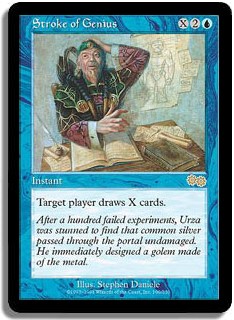
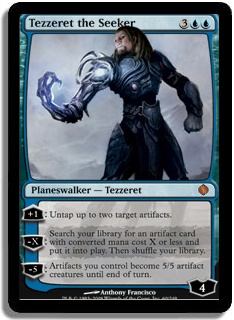
No comments:
Post a Comment